
Thank you for reading this story. I would suggest to keep at least 2 days for Angkor Wat complex to explore it thoroughly. You can buy a 3-day pass instead of buying two 1-day passes as that will be cheaper. Hope this helps.
915 views
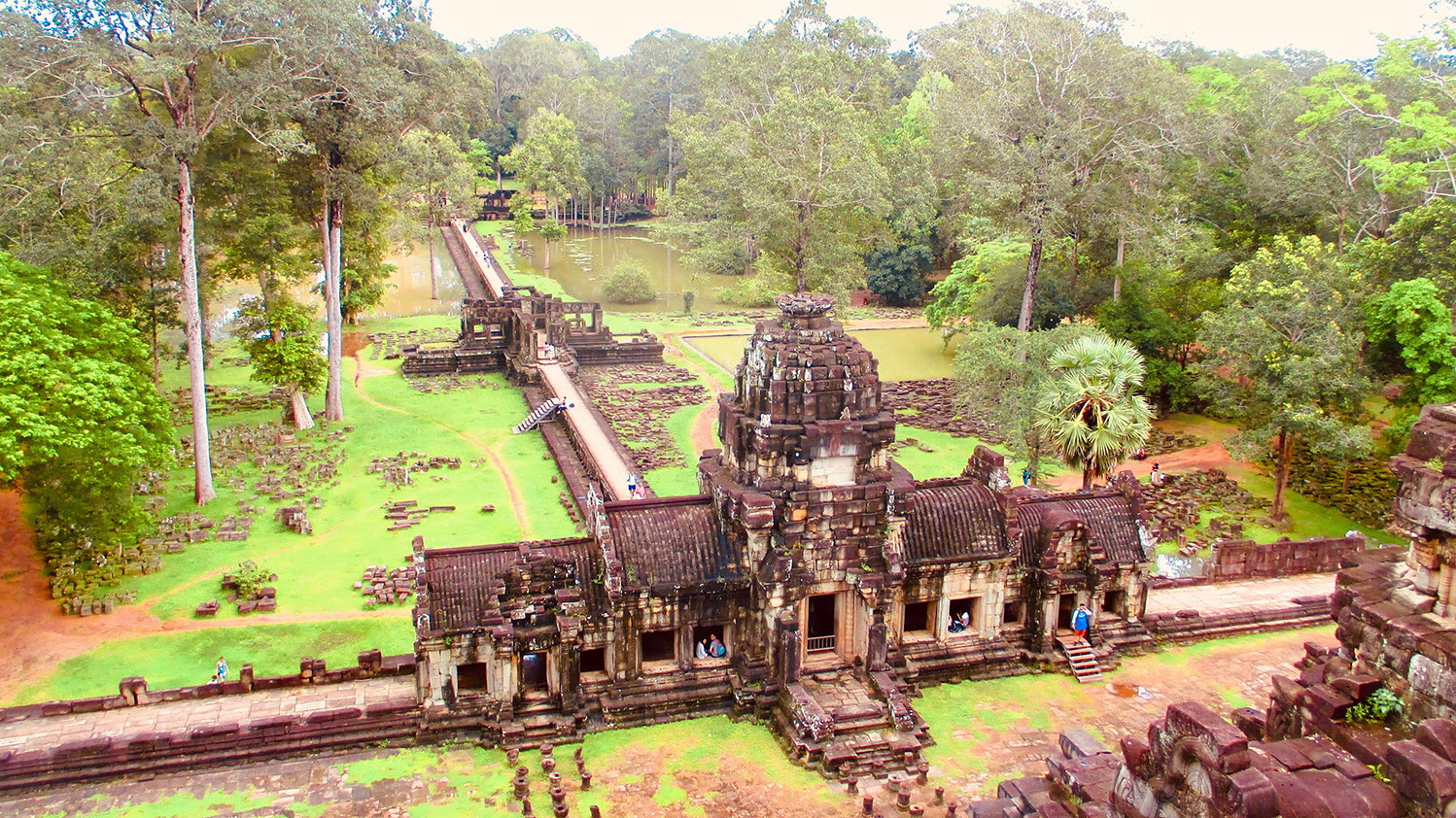
Siem Reap is considered as the spiritual hub of Cambodia and rightfully so with the magnificent Angkor Wat Archaeological Park that includes around 72 major temples and other structures in the complex with several hundred minor temple sites scattered across the landscape. The kings of the Khmer Empire seemed to be obsessed with building architectural masterpieces. No wonder this complex is the largest religious monument in the world! This also justifies the millions of visitors that Siem Reap attracts each year.
While visiting Siem Reap, a tour of Angkor Wat is on everyone's top priority list. Mostly, visitors cover the entire complex in one day. I personally feel a day's tour makes it very rushed and does not do justice to this historical treasure trove. There are different passes that one can purchase to access the complex depending on one's level of interest. I spent almost half a day in the most intriguing historic ambience of the main Angkor Wat temple and was totally mesmerized by the enormity and magnificence of the place. Since I lived in Cambodia for some time, I had the luxury of visiting Angkor Wat Complex several times, with each visit more interesting than the other.
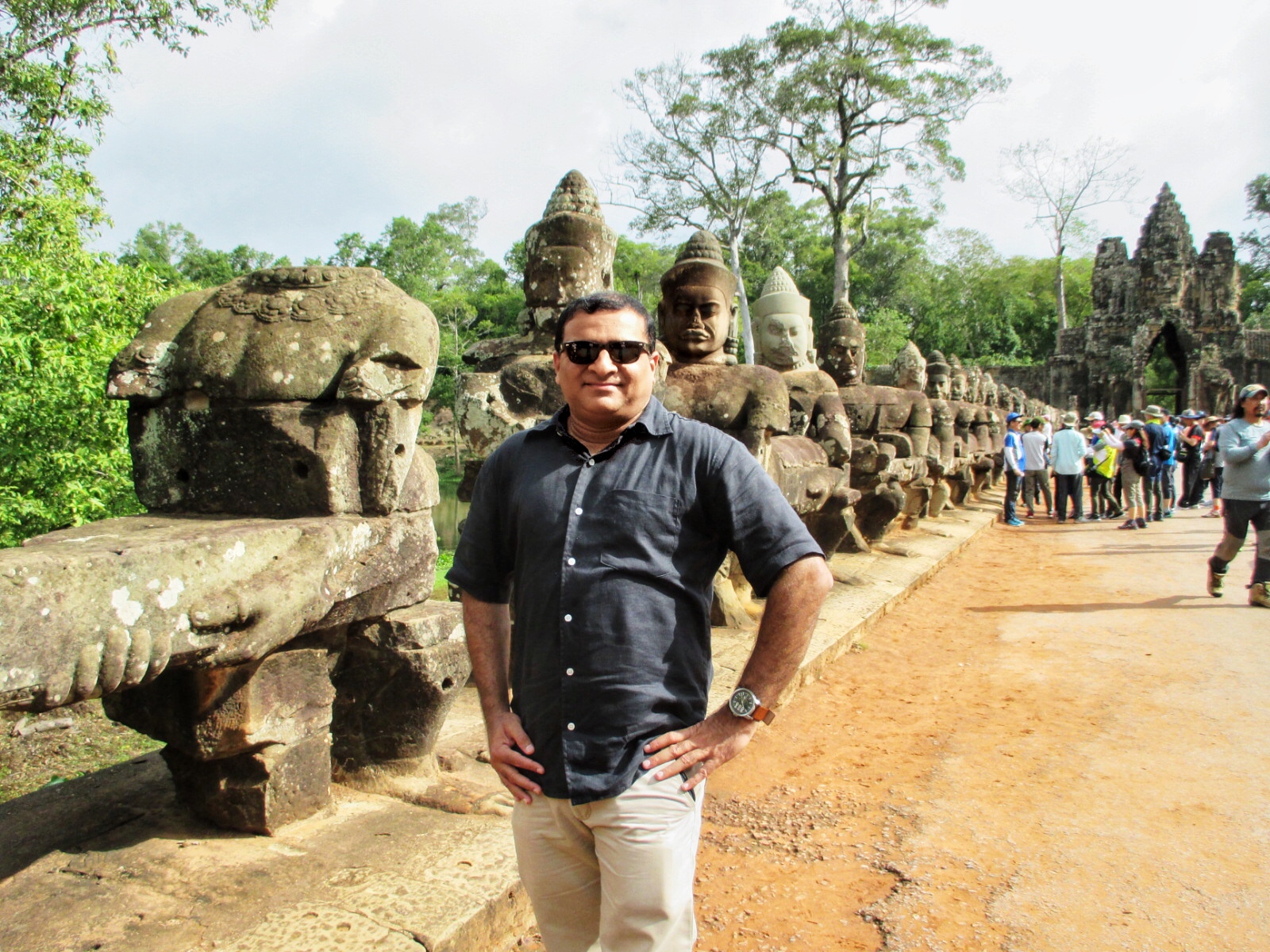
That's me posing in line with the numerous statues behind me
There are many temples in the Angkor Wat Complex.The complex has Buddhist and Hindu Temples dating back to the 10th century. Some structures have deteriorated and are covered with foliage, while others are a history buff's paradise. I have spent time in a few of these temples and trust me, one temple out does the other with their bas-reliefs, structural design and enormity. Exploring the lesser-known temples which are equally mesmerizing takes travelers off the beaten path.
If you plan to cover the entire Angkor Complex, I strongly recommend that you hire a highly knowledgeable guide, preferably one who speaks your native language. Surprised by the language options? There is a system in place at Angkor Wat that involves an authorised guide who has been issued an ID card by APSARA (Authority for the Protection of the Site and Management of the Region of Angkor). There is a selection process based on the guides' knowledge and their language proficiency. Many local guides speak English, French, German, Italian, Spanish, Japanese, Chinese, Korean, among others. It is forbidden for guides assigned to a particular language to entertain tourists in other languages. Alternatively, you can choose from a variety of guided tours online. Trust me, they're good. A private guide is a tad pricey, but you're unlikely to visit Angkor Wat again anytime soon.
Don't worry if you're still on a budget. There are lots of group tours in Angkor Wat, and they have knowledgeable guides. You will be able to join the tour of your choice and save money in the process. Group tours typically consist of 15 to 20 participants.
Cambodia remains fairly hot and humid throughout the day, even during the dry season. It's imperative to choose accommodation where you can relax and rejuvenate after a tiring day exploring temples. In Siem Reap, you'll find a variety of hotels to fit any budget.There are many hotels that offer a Tuk-tuk or taxi with a friendly driver who can guide you on what to do and what not to do during your stay. This way, you're safe from cheaters.There are many hotels that offer a Tuk-tuk or taxi with a friendly driver who can guide you on what to do and what not to do during your stay. This way, you're safe from cheaters.
Check out these hotel deals in Siem Reap.
There are plenty of Airbnbs and long-term homestays if you're on a budget. Cambodian hosts are usually friendly and welcoming. Hostels are also plentiful in Siem Reap.
Find the best hostel in Siem Reap.
Khmer King Jayavarman VII established Angkor Thom (Great City) in the late 12th century spanning about 12 sq. kms and lies on the west bank of the Siem Reap River. The current city of Siem Reap is developed around Angkor Thom. The current Angkor Wat Complex resides within Angkor Thom. Names of places always have fascinating stories of how they originated. I have always been curious about this and try to figure out the origin. Angkor Thom, sometimes referred to as Nokor Thom meaning "Great City" in Khmer, was the last and most enduring capital of the Khmer Empire. Nokor is derived from the Sanskrit word Nagara, which means city, combined with the Khmer word Thom, which means great.
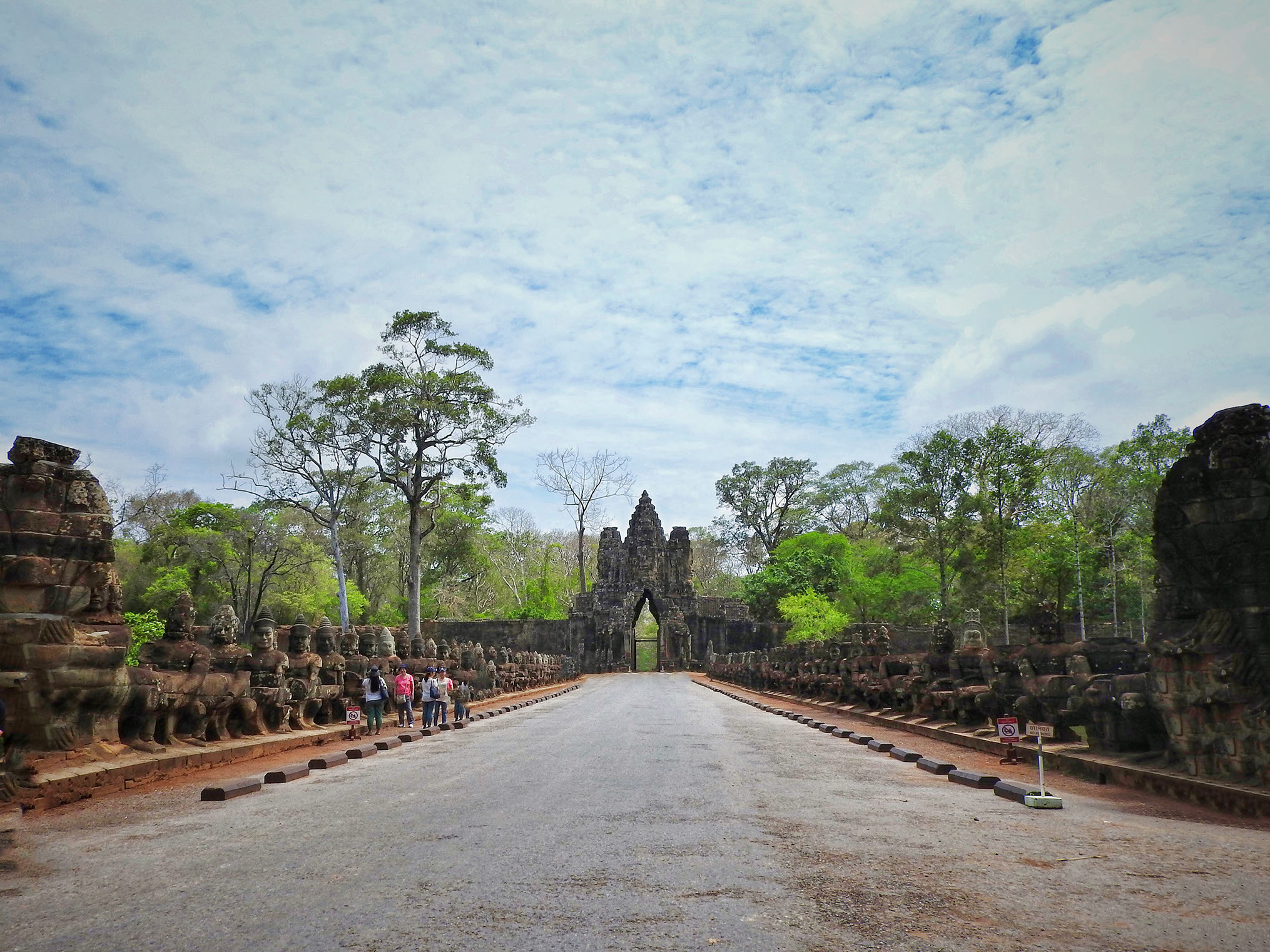
The South Gate of Angkor Thom is possibly the best preserved with carved faces lining the causeway
While I did my own research about Angkor Thom, my highly knowledgeable guide shared a ton of interesting information about the place. It is said that King Jayavarman VII built this city as a symbol of his power and a show of defiance against the invading Cham people. At its peak, Angkor Thom was home to 80,000-150,000 people. However, it was sacked by King Borommarachathirat II in 1431, forcing the Khmers to relocate their capital southeast to Phnom Penh. Angkor Thom was abandoned some time prior to 1609. It remained uninhabited for centuries, until it was rediscovered by French explorers in the 19th century.
Angkor Thom displays the Bayon style of architecture which is characterized by large-scale construction and the widespread use of laterite, an easily-quarried stone that was used extensively in Khmer architecture. The city is surrounded by a moat 65 meters wide and six meters deep which represents the world ocean. There are five entrances to the city; one each to the east, north, west and south and a fifth leading directly into the Royal Palace compound in the center of the city. Each entrance is flanked by giant statues representing Garudas, mythical beasts that served as a vehicle for Hindu God Vishnu, as well as Khmer soldiers.
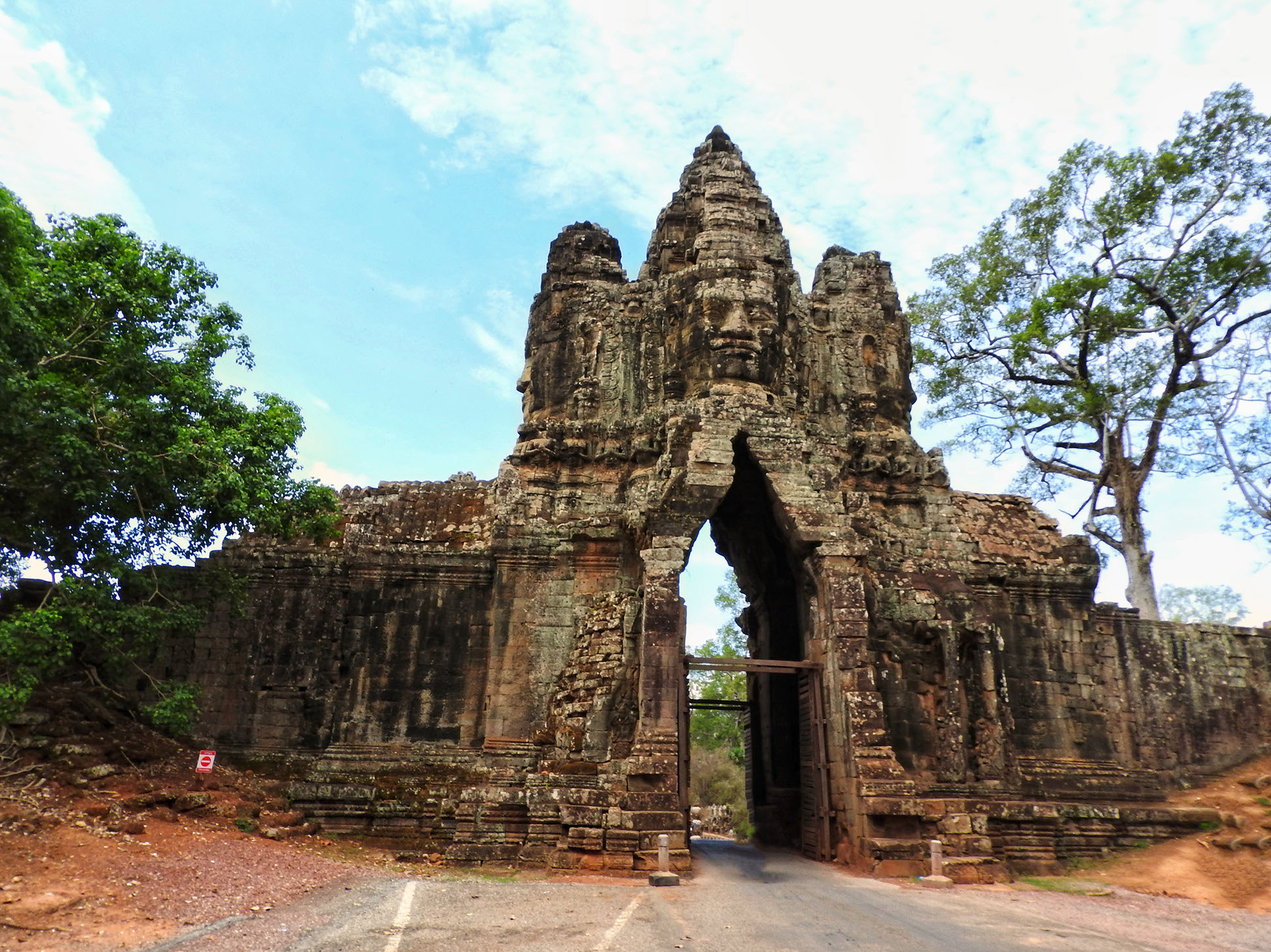
North Gate of Angkor Thom known as Thvear Ta Nok has a stone bridge lined with Asura and Deva on either side
The walls of the city are flanked by a moat with gates at each of the cardinal points. Each tower has a causeway spanning the moat, with rows of devas on the left and asuras on the right, each holding a naga as the guardian figure. This represents Samudra Manthan, the churning of the ocean.
Angkor Thom was once a thriving city with an extensive canal system which linked the northeast to southwest. The ruins of this ancient metropolis contain vast displays depicting various gods and goddesses from Hinduism, later modified by Buddhism.
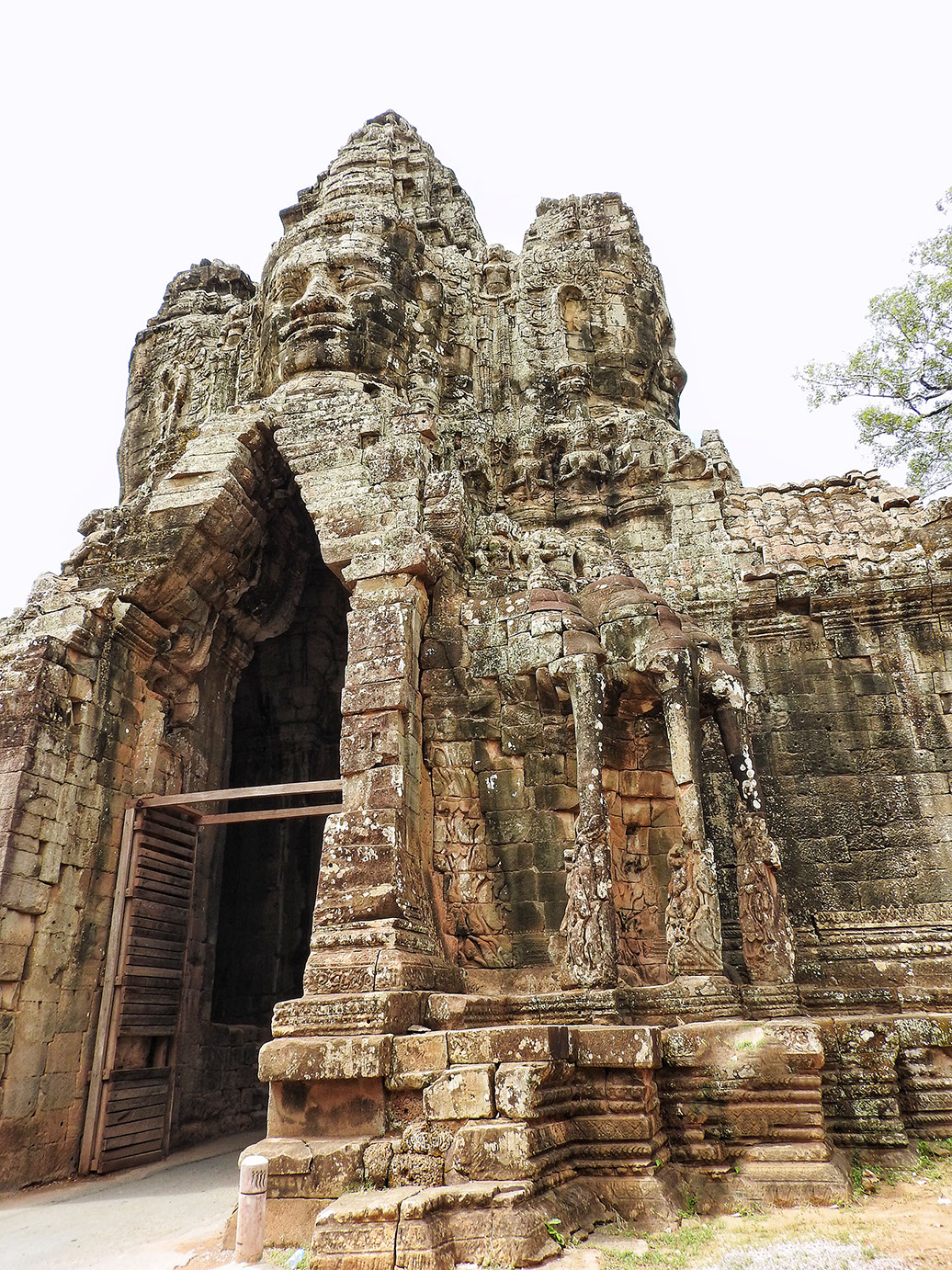
The intricate architecture of the gates at Angkor Thom are a testimony of a architectural-rich Khmer Era
Moving on, the next masterpiece inside Angkor Thom is Bayon Temple. It was built in the late 12th to early 13th century as a state temple of King Jayavarman VII. It represents the creative genius of the most celebrated Khmer King of Cambodia. The most distinctive feature of the temple is the multitude of serene and smiling stone faces that adorn its walls and towers. These faces are of the Mahayan Bodhisatva Avalokiteshvara and are often misunderstood as being those of the Hindu creator god Brahma. The Japanese conservatory body described the temple as "the most striking expression of the baroque style" of Khmer architecture, as contrasted with the classical style of Angkor Wat. It is truly an exquisite structure that left me in awe.
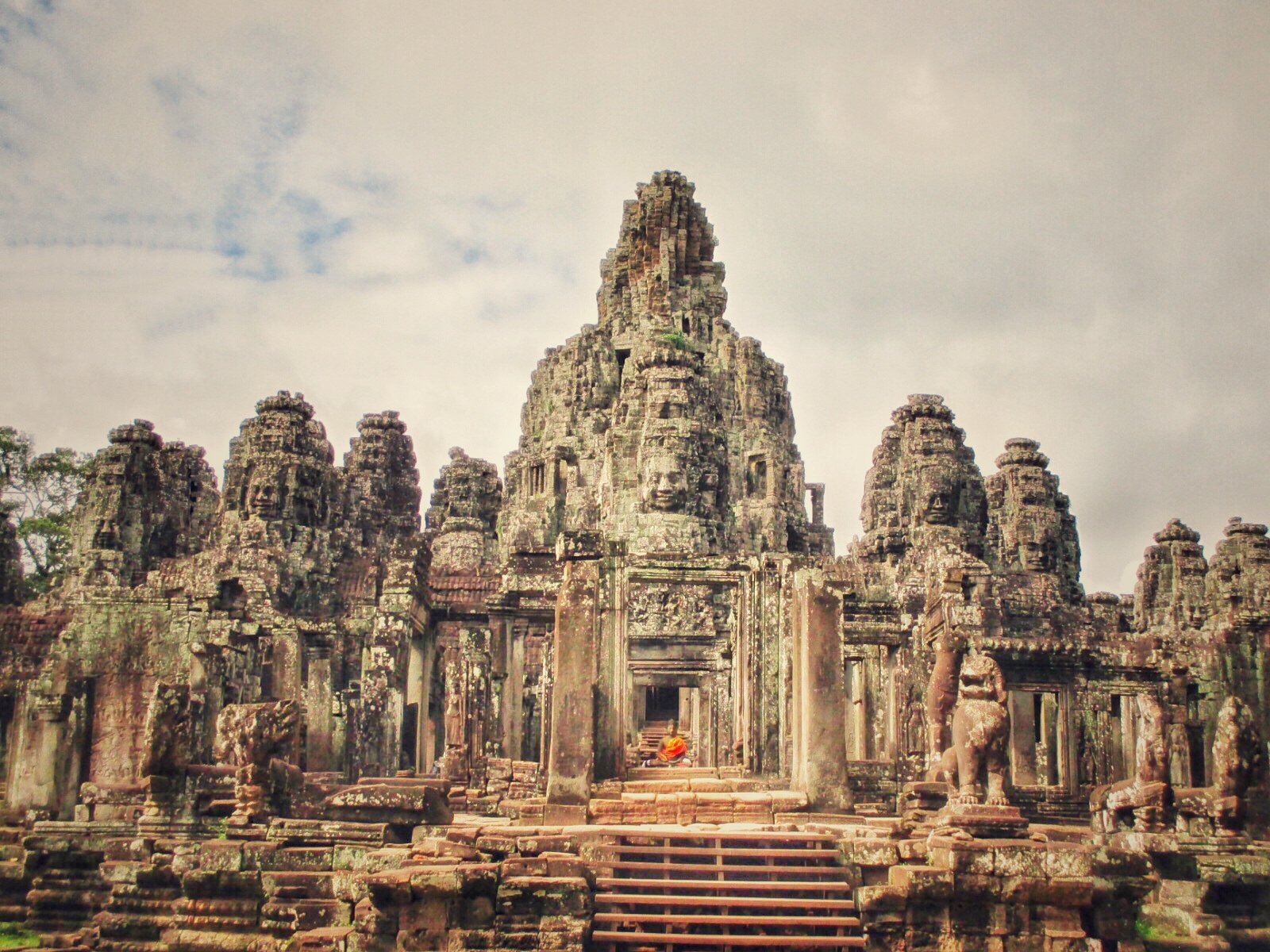
The Bayon Temple with the enormous smiling face stone towers is a masterpiece
Bayon (originally Jayagiri Victory Mountain) stands in the middle of the capital city of Angkor Thom. From outside, this temple looks more like rubble but the magic becomes apparent inside, especially on the upper levels. Unfortunately, the upper levels were closed for restoration when I first visited. The temple restoration work is a collaborative effort of Japan and Cambodia. The Bayon temple has 54 Gothic Towers decorated with 216 gigantic smiling faces of Buddha. Each tower has 4 faces of Buddha in each direction and all the faces are not exactly similar. There is a theory that the faces are representations of Jayavarman VII himself. This is a top choice temple in the complex and is best visited during late afternoon.
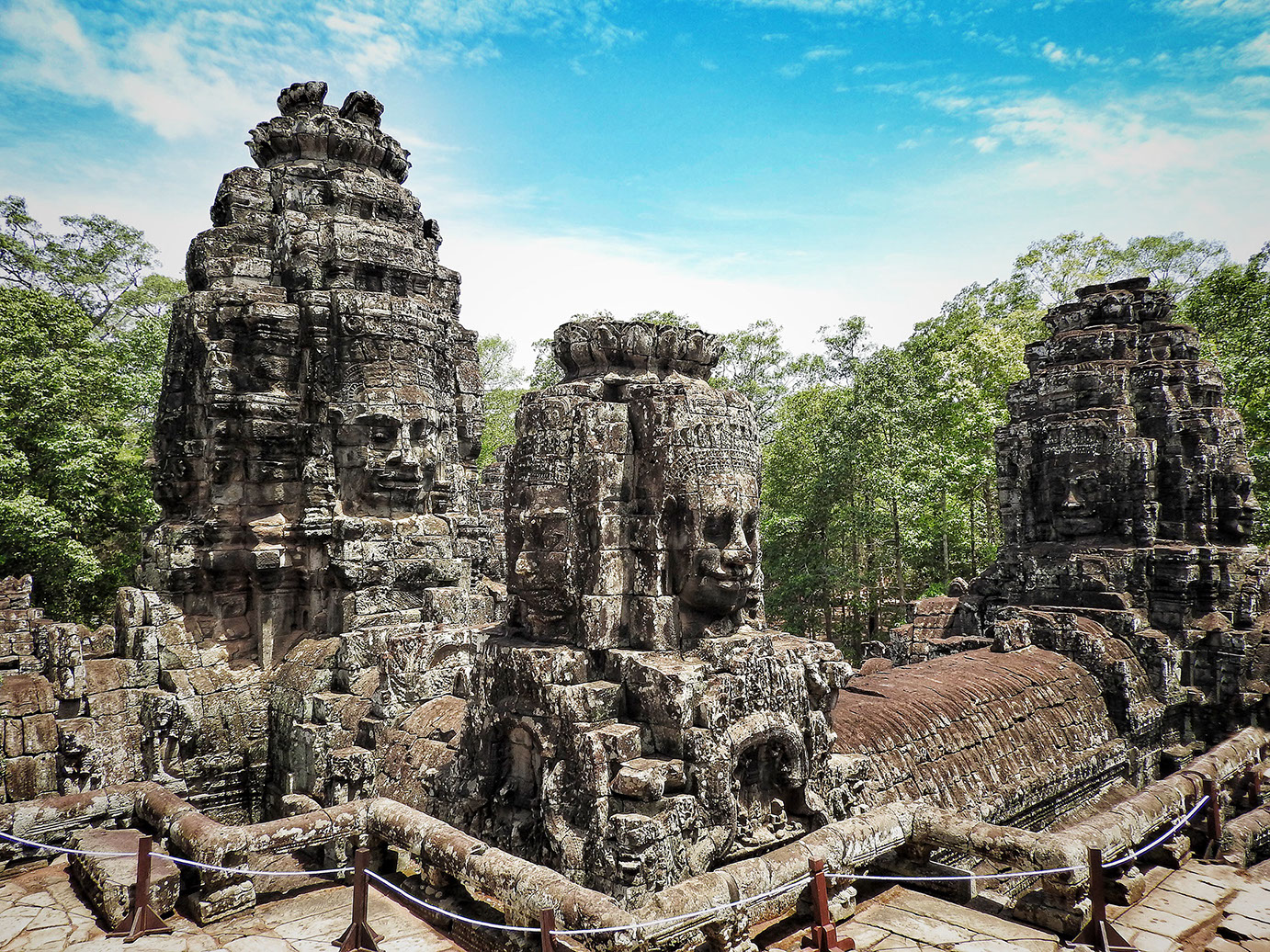
The multitude of smiling stone faces on the towers of Bayon Temple makes it a unique sight
The temple was built at a time when the Khmer empire was experiencing a resurgence of Buddhist activity. King Jayavarman VII was a devout Buddhist, and he undertook a large-scale program of religious construction, including the Bayon Temple. However, the empire subsequently reverted to Hinduism in the mid-13th century, and the temple was altered to reflect this change in religion. The original name for the Bayon was Jayagiri or "Victory Mountain." The temple became known as Banyan Temple after French occupancy due to its Buddhist imagery and religious significance.
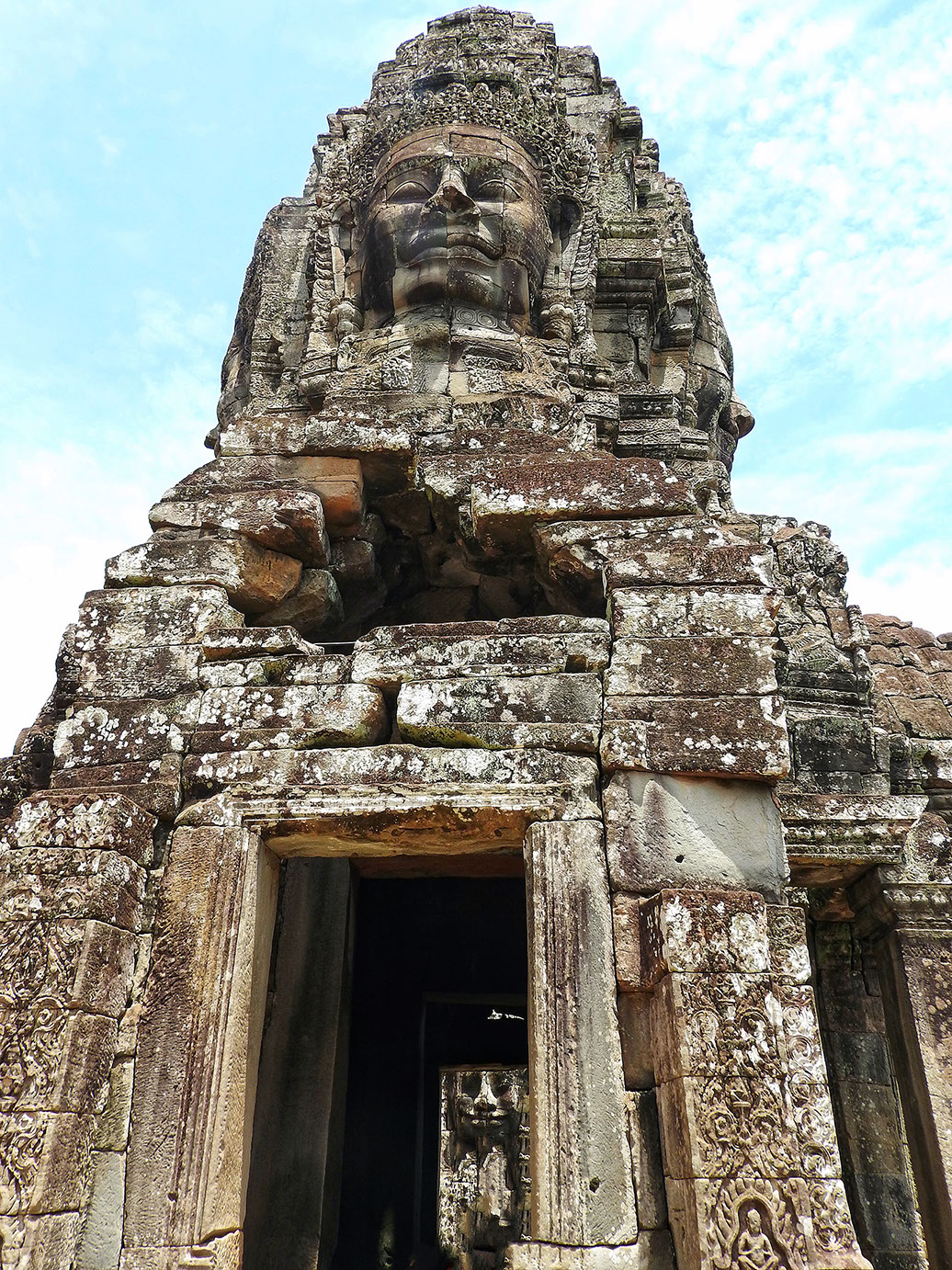
The walls and pillars of Bayon Temple have carvings that form a fascinating storyboard
Bayon is oriented towards the east, and it sits at the exact center of the city. It is directly accessible from each of the city's cardinal points by road. The temple has no wall or moats, and it is surrounded by a wide open space. It consists of two galleried enclosures and an upper terrace, which are all crowded against each other with very little space between them. This compact design creates a sense of intimacy and encloses the viewer in a close-knit space, which is further accentuated by the numerous carved faces that stare down from the walls. The overall effect is quite mesmerizing.
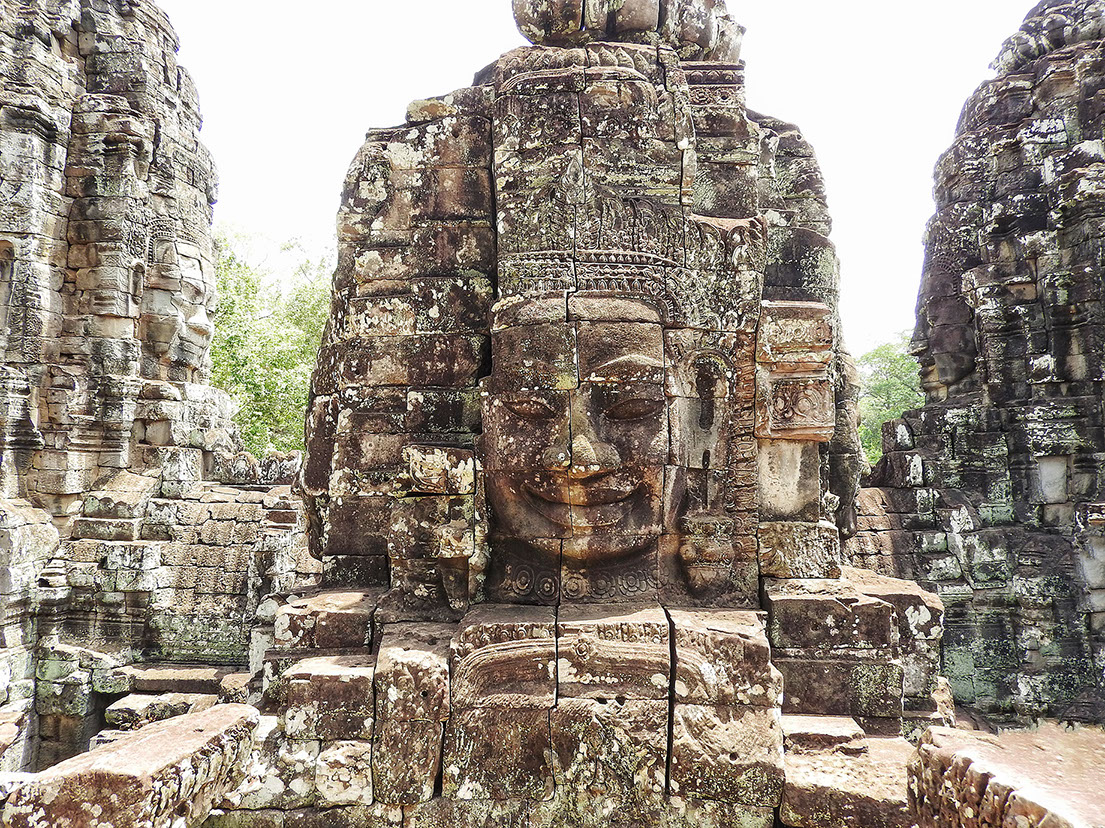
The upper terrace of the Bayon Temple with stone faces of mahayan bodhisatva avlokiteswara
The outer gallery is decorated with bas-reliefs that depict historical events and scenes from Khmer daily life. These reliefs are highly detailed and informative, and gave us valuable insight into the culture and history of the Khmer people. In addition to the outer gallery, the Bayon Temple also encloses a courtyard with two libraries. These libraries were used by the monks who lived at the temple.
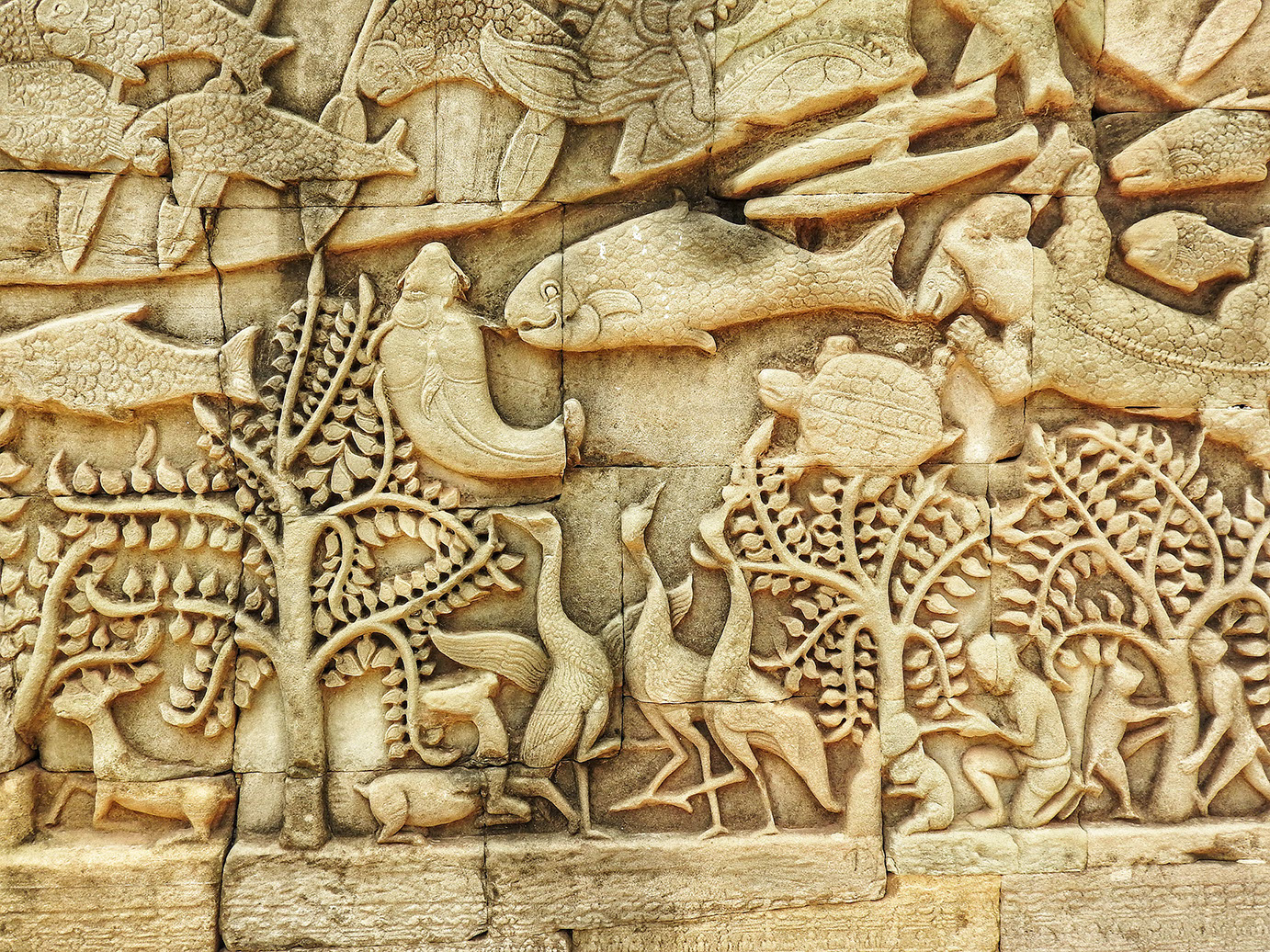
These intricate carvings depict the daily life of people during the Khmer Era
The inner gallery is raised above ground level and has double corners. It is decorated with scenes from Hindu mythology, and its bas-reliefs are in stark contrast to those of the outer gallery. The inner gallery was a later addition of King Jayavarman VIII, and it is believed to have been used for religious ceremonies.
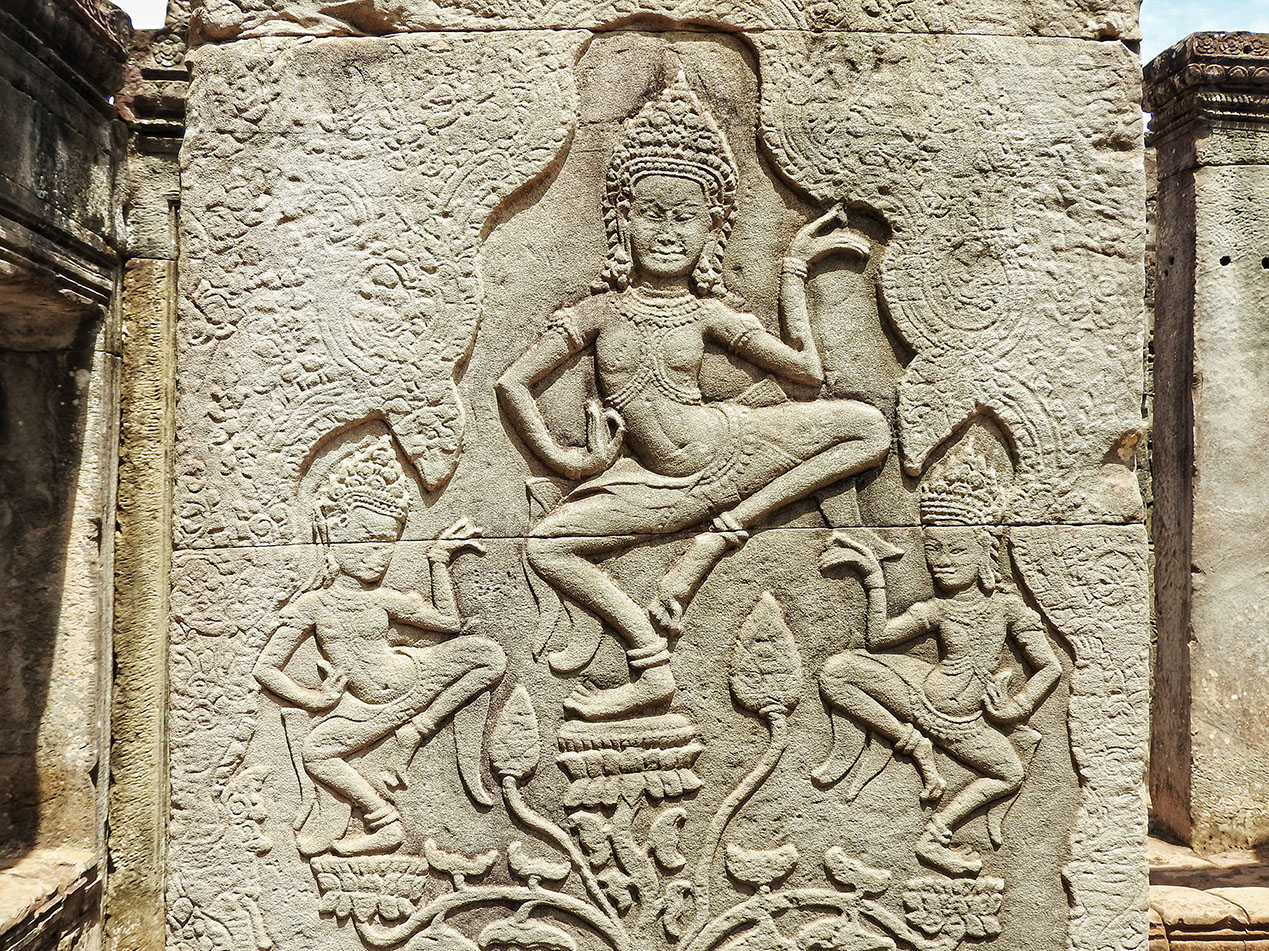
The intricate and delicate carvings depict Apsaras
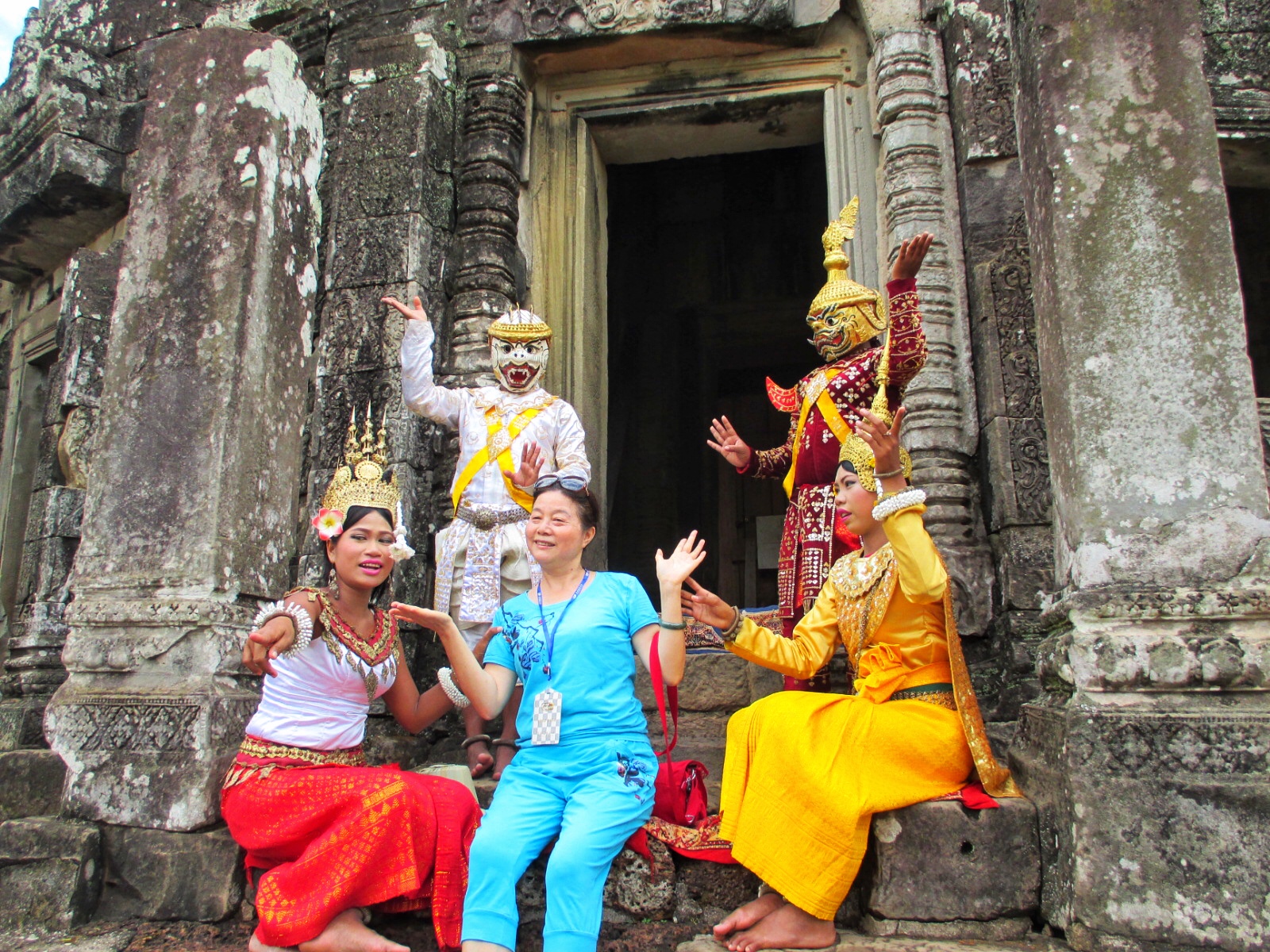
Locals perform an Apsara dance inside the temple where tourists can take their pictures
The upper terrace is one level higher than the inner gallery and is filled with statues of Buddha. The lack of space between the inner gallery and the upper terrace has led to the belief that the upper terrace did not figure in the original plan of the temple. However, the upper terrace is home to the famous "face towers" of the Bayon, which are a key feature of the temple. This temple is probably the most fascinating owing to its design and storytelling walls.
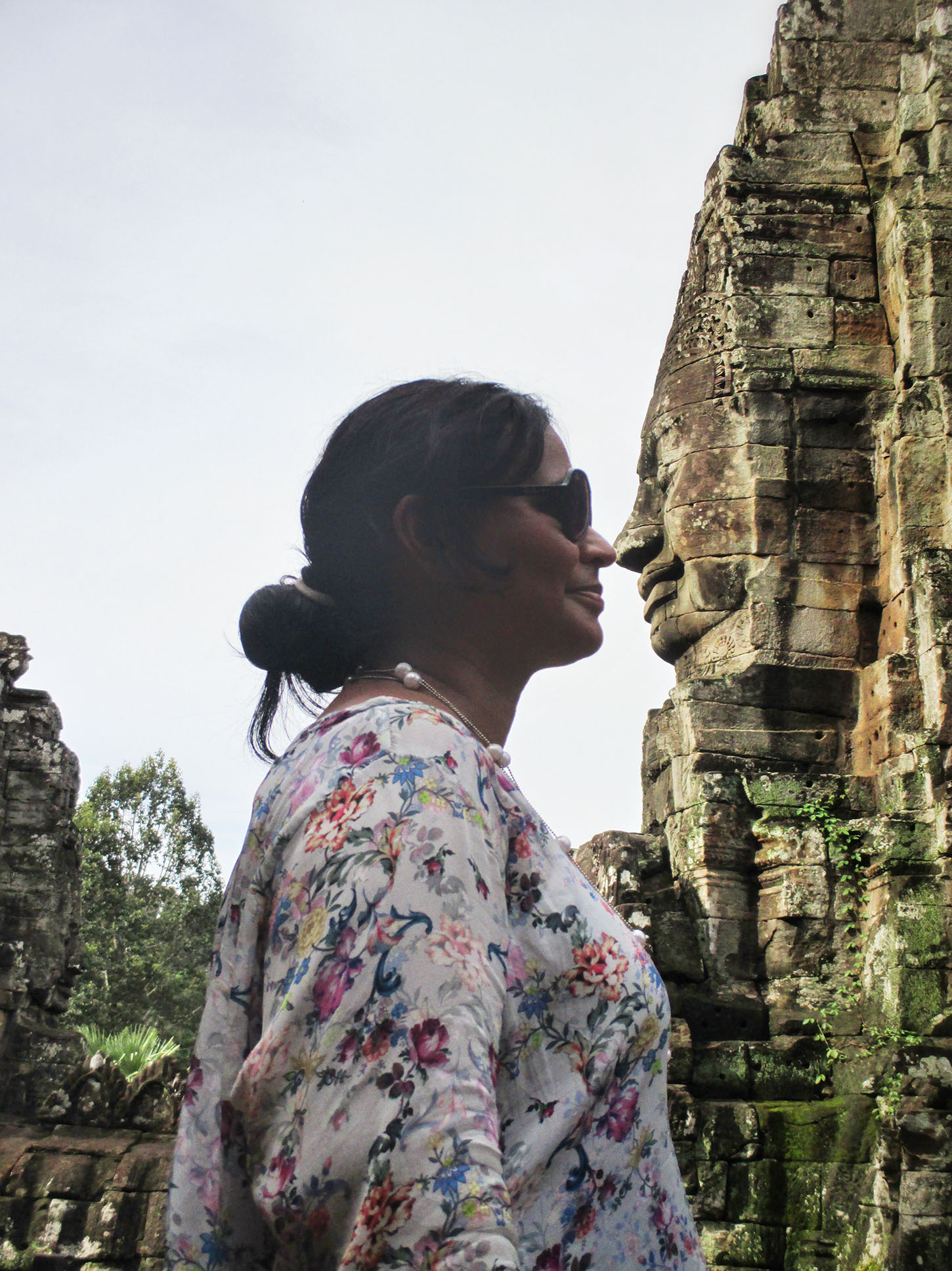
A face-to-face "mirror" image of my wife with the face towers
In 1186 C.E., Jayavarman VII embarked on a program called Rajavihara, or "monastery of the king." The objective of this program was the construction of public works, including temples, canals, and roads. Ta Prohm was the first temple to be built pursuant to this program. The temple is dedicated to the Hindu god Brahma, and its name in Khmer means "ancestor Brahma". The temple was once a thriving center of religious activity, but it was abandoned after the fall of the Khmer Empire. Today, the temple is in a state of ruin, with its massive stone blocks entangled in the roots of giant trees. It is now a popular tourist destination, and its unique atmosphere of mystery and decay continues to fascinate visitors from all over the world.
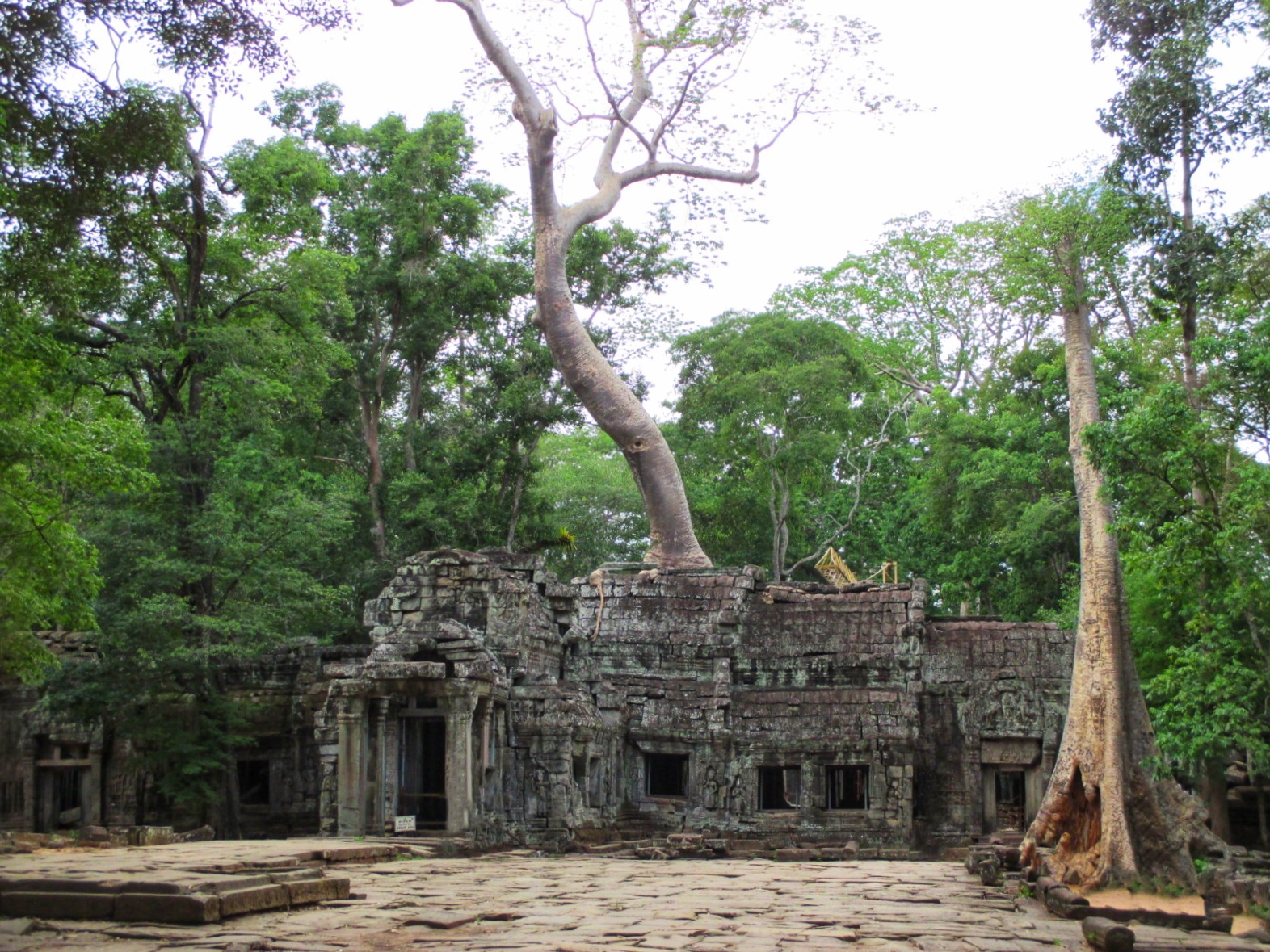
The front view of Ta Prohm from outside the main entrance at east side pathway
The Rajavihara program was built in honor of King Jayavarman's family. As we walked through the different areas of the temple, there were images that represented members of his family and their most prominent characteristics. The main image in Ta Prohm temple is of Prajnaparamita, the personification of wisdom. It is said that the image was modeled on the king's mother. In addition, there are two other temples in the complex. The southern and northern temples were dedicated to his brother and Guru Jayamangalartha, respectively. The Rajavihara Temple Complex is a testament to Jayavarman's dedication to his family and his loyalty to his guru. Ta Prohm was home to more than 12,500 people, including 18 priests and 615 dancers. The temple was quite wealthy, with gold, pearls and silks among its riches. Expansions to Ta Prohm continued until the 15th century.
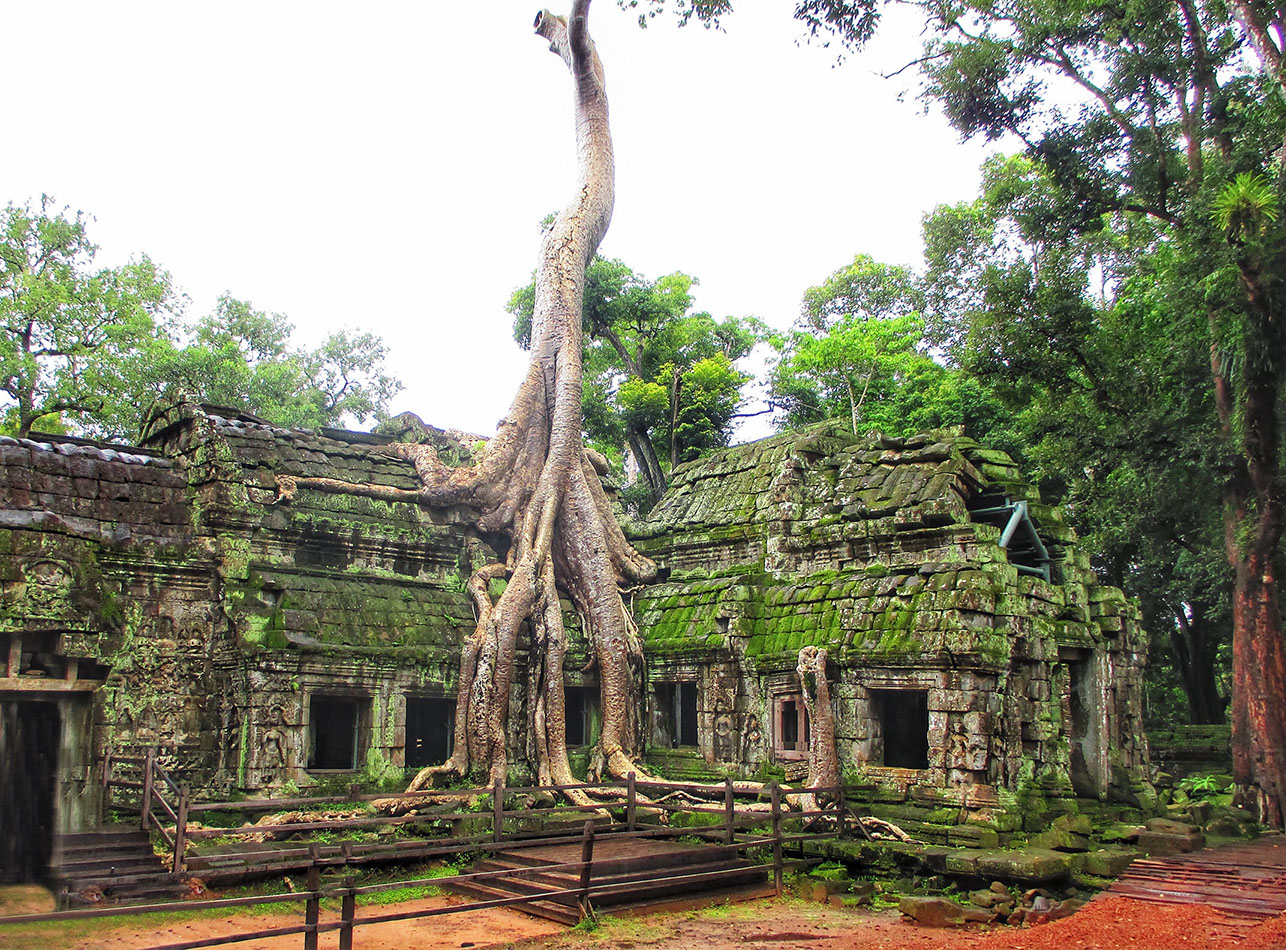
The Crocodile Tree is what you see immediately after you enter the temple premises and turn around
For centuries, the Khmer Empire flourished in what is now Cambodia. However, by the 15th century, the empire had begun to decline. This culminated in the fall of the Khmer Empire in 1431. As a result, many of the empire's cities were abandoned, including the royal capital of Angkor. While some ruins were subsequently looted, many were simply left to return to nature. This is particularly evident at Ta Prohm, where tree roots have engulfed entire buildings. Today, the ruins of Ta Prohm stand as a testament to the power of nature and the transitory nature of civilization.
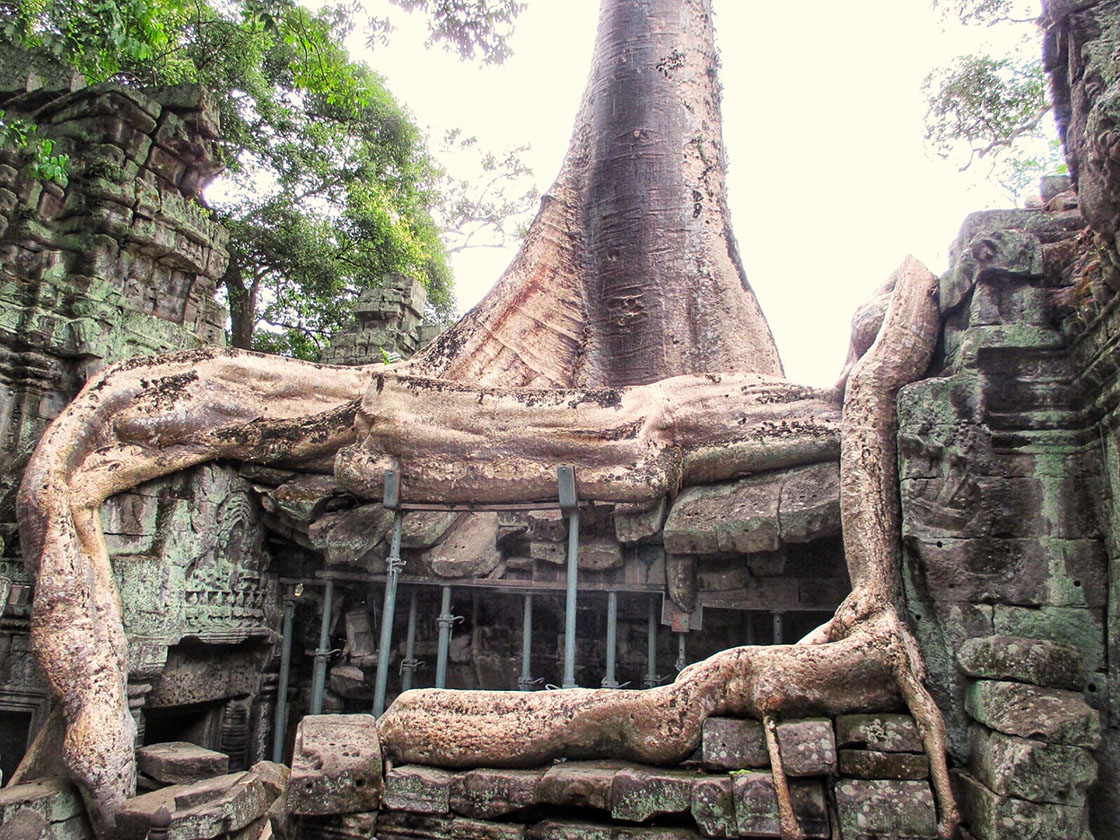
One of the many intriguing views on entering the temple premises
The design of Ta Prohm is that of a typical "flat" Khmer temple. The temple is oriented to the east, and the outer wall of 1000 by 650 meters encloses an area of 650,000 square meters. The temple would have been the site of a substantial town, with entrance at each of the cardinal points. Today, access to the temple is only possible from the east and west.
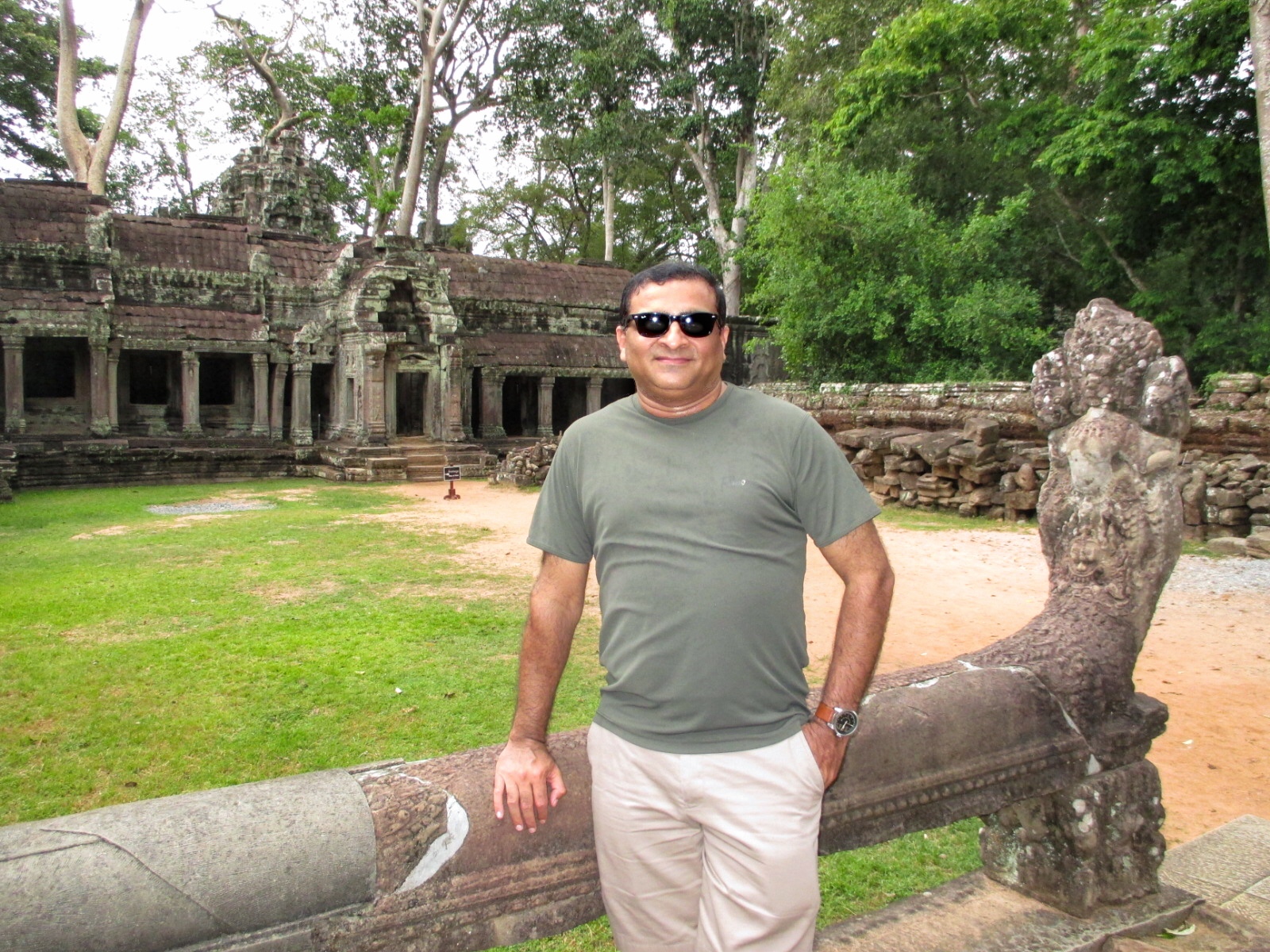
There are many spots for great photo ops and this view from the west side entrance is one of them
The three inner galleried enclosures of Ta Prohm form a quincunx (similar to Angkor Wat), with the corners occupied by towers. The entrance is in the middle of the east side of the first enclosure, and the most substantial building is the library in the southeast corner of the first enclosure. To the north and south of the library are two smaller temples, each with two chambers and an entrance in the middle of the side facing the library. The plan is complicated for visitors to decipher because of circuitous access to the second and third enclosures, which are entered from the north and south sides of the first enclosure respectively. In addition, there are numerous chambers and hallways leading off from the galleries, some of which are blocked by fallen debris. It is always recommended to have a knowledgeable guide who can take you through the maze while enlightening you about these incredible historic monuments.
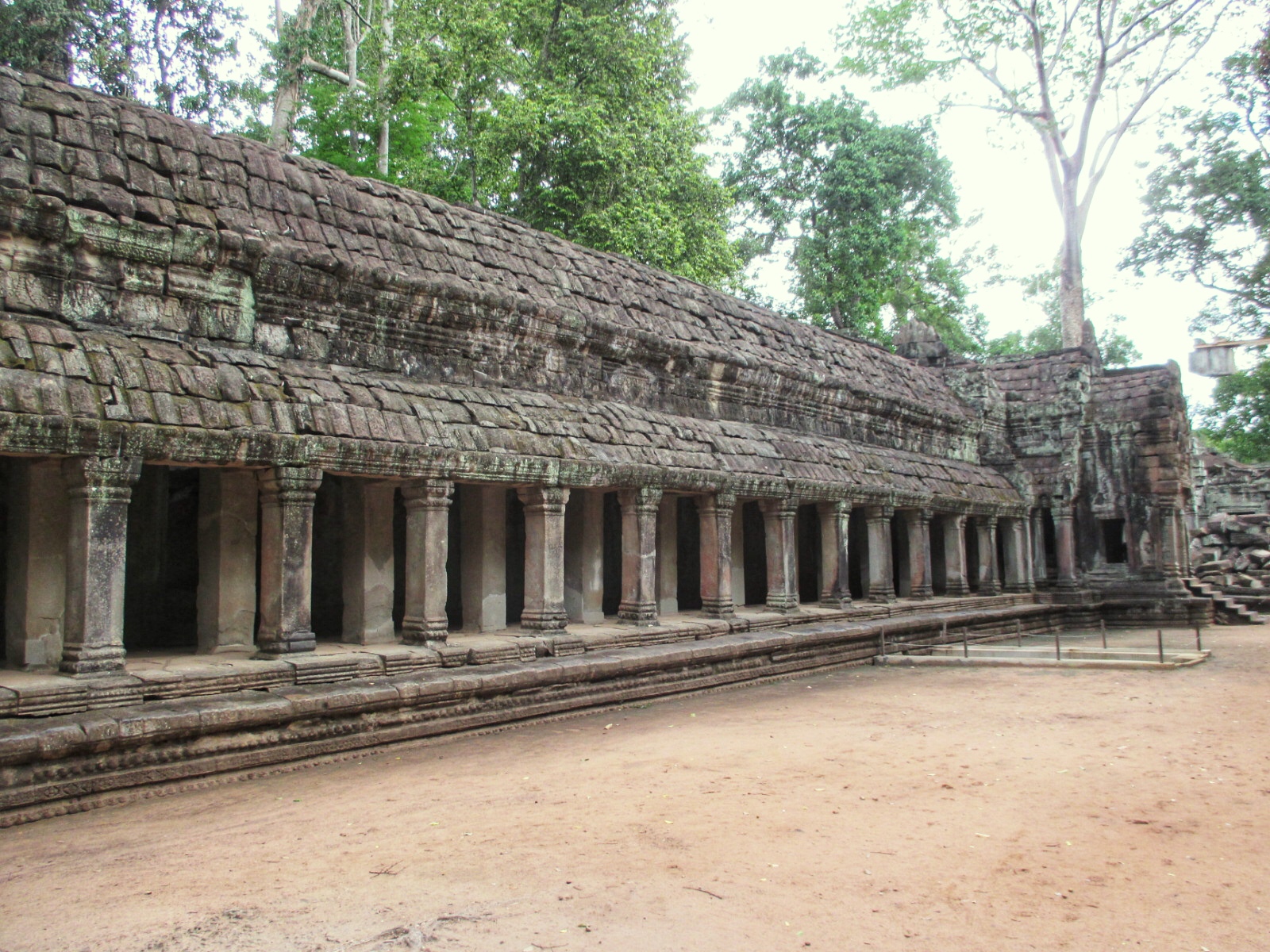
The third inner enclosure has numerous hallways and chambers
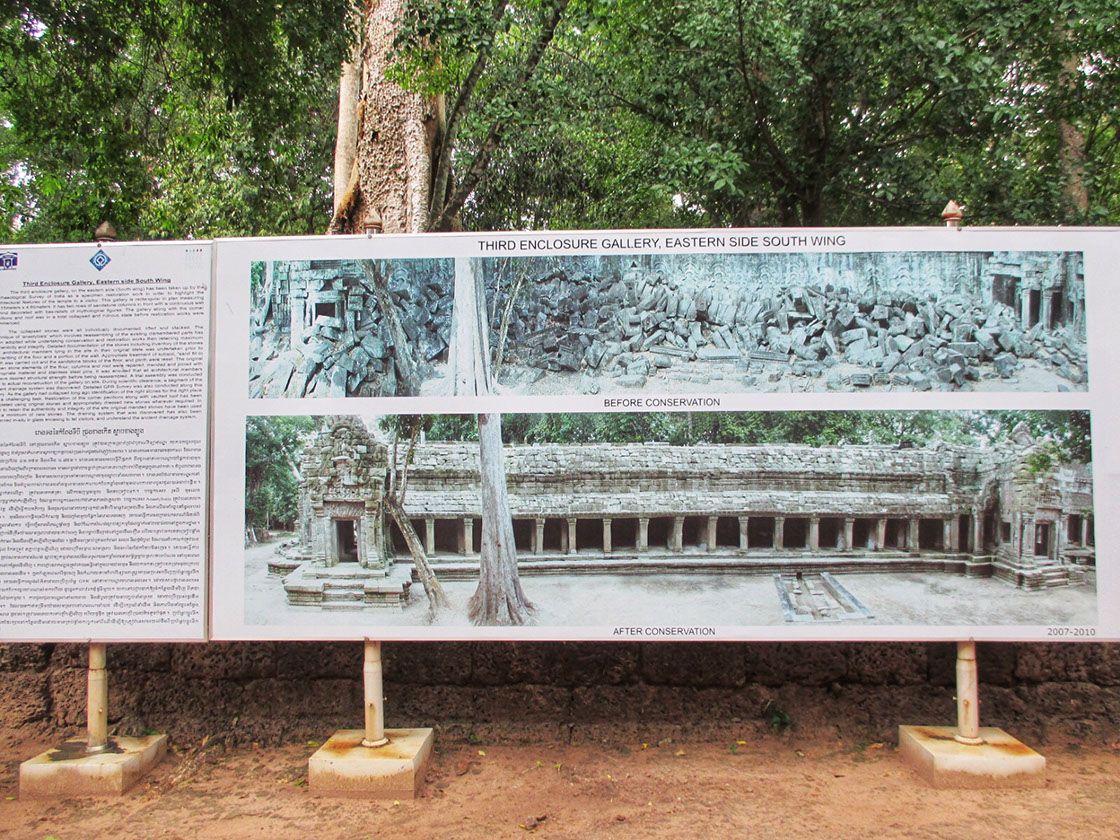
A plan of the resurrection work planned which is a joint project between Archaeological Survey of India (ASI) and APSARA
The temple is famous for its unique architecture, which combines elements of both Hindu and Buddhist traditions. Unlike other Khmer temples, Ta Prohm does not have many bas-reliefs. However, there are some stone reliefs of Hindu deities and some depictions of scenes of Buddhist mythology of "Great Departure". The temple was sacked by the Chinese in 1431 and was further damaged by the Thai in 1432.
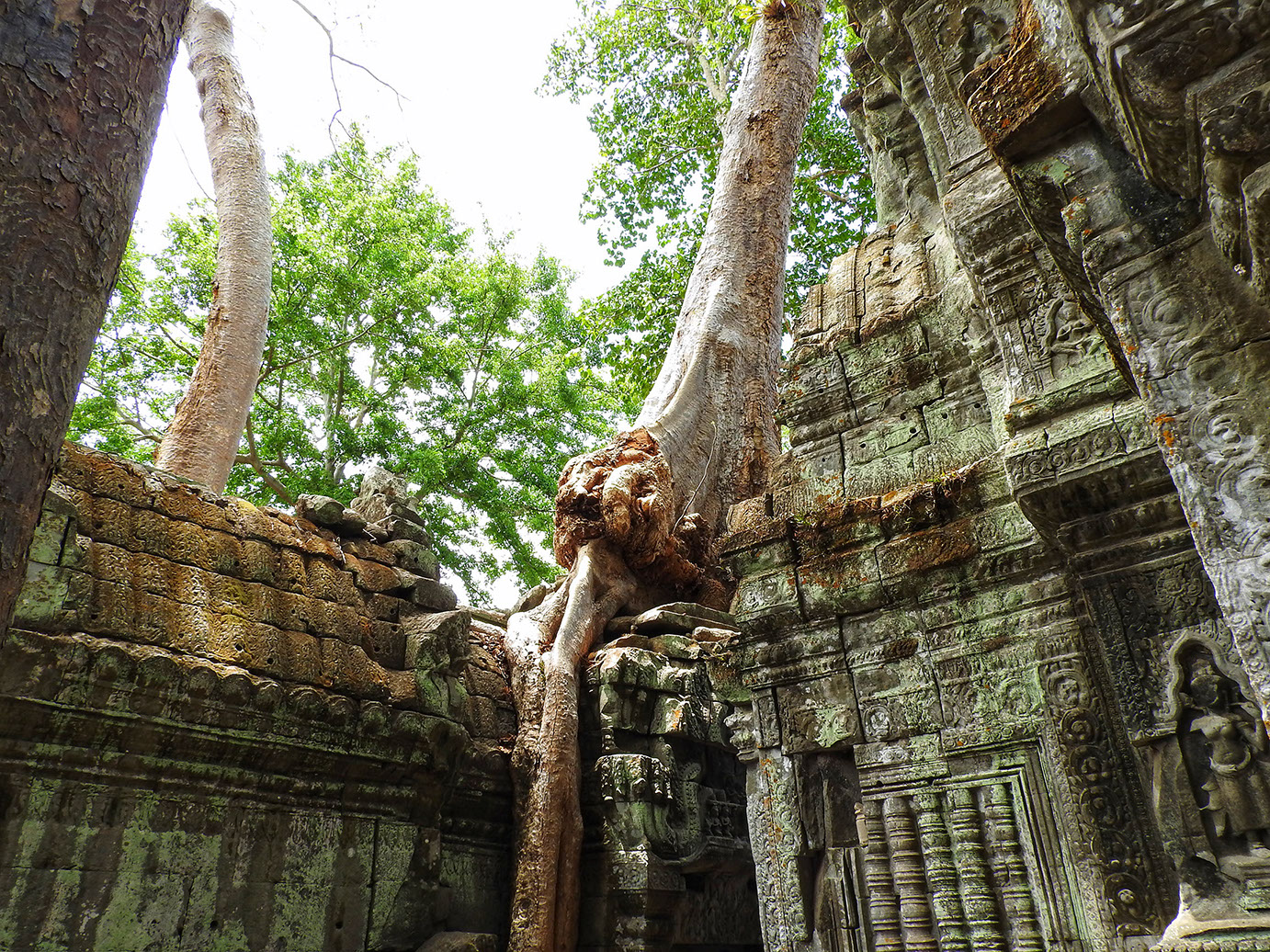
Intricate bas-relief depictions similar to what we see in Angkor Wat Temple
Of all the temples at Angkor, Ta Prohm is perhaps the most distinctive. It is characterized by its dense jungle growth. Trees and vines cover every surface. Director Jacques Cousteau once called it "the strangest place on earth." The two species of trees that predominate are the silk-cotton tree and the thitpok. The larger of the two, the silk-cotton tree can grow to be over 100 feet tall. The smaller thitpok is a member of the fig family and has aerial roots that wrap around the trunk of the tree. Both the silk-cotton tree and the thitpok are native to Southeast Asia. The other two species of trees that are found at Ta Prohm are the strangler fig and the gold apple. The strangler fig is a parasitic tree that begins its life as a seedling high in the branches of another tree. Over time, it sends out roots that drop to the ground and begin to strangle its host. The gold apple is a small tree with fragrant flowers that bloom in shades of red, pink, and white.
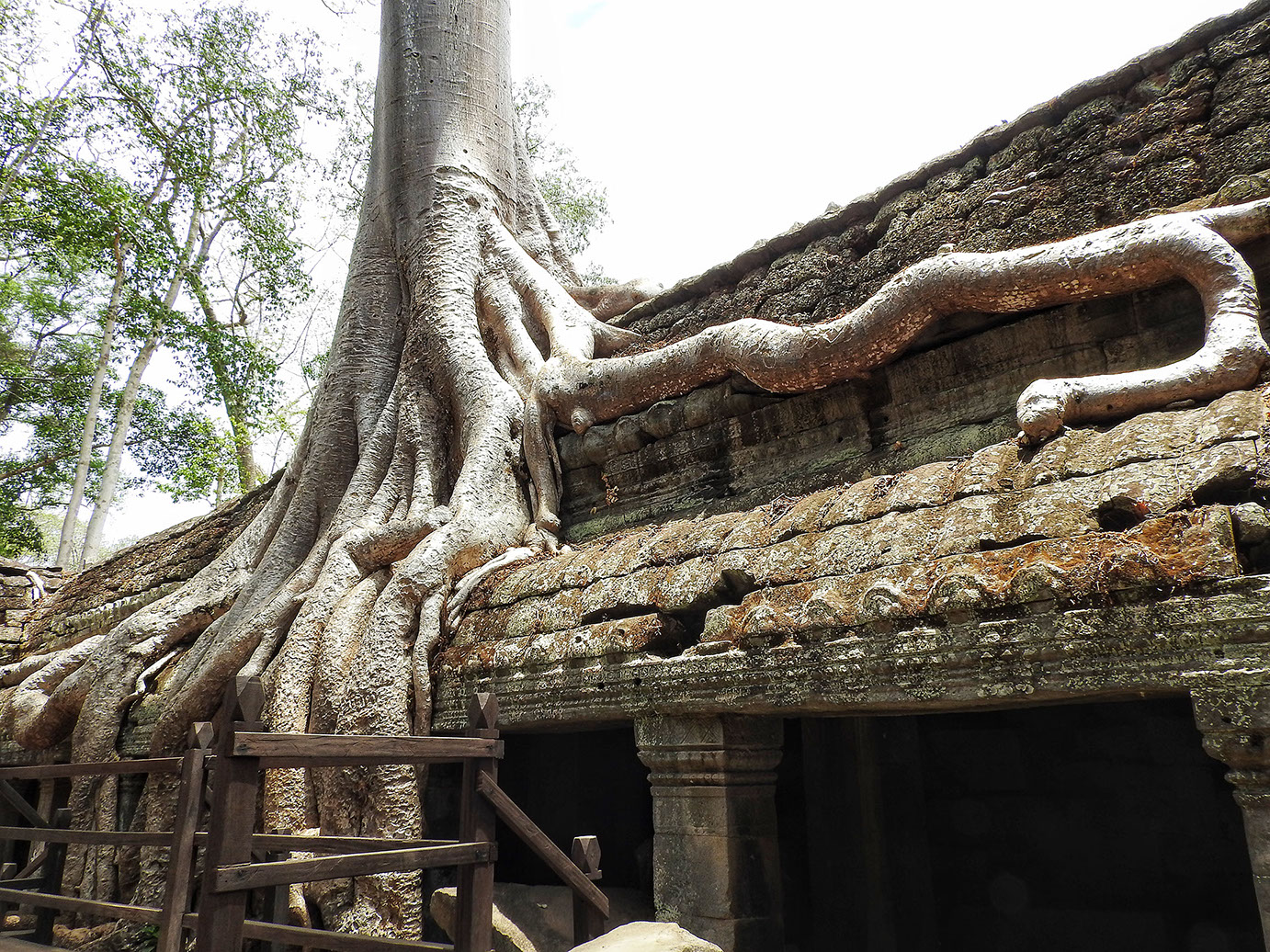
The thick vegetation in Ta Prohm blends into the intriguing structures
The most popular of the numerous intricately entangled root formations is the "Crocodile Tree". It is the one inside the easternmost gopura (entrance pavilion) of the central enclosure. It is also popularly known as the Tomb Raider Tree because it is here that Angelina Jolie's Lara Croft was featured.
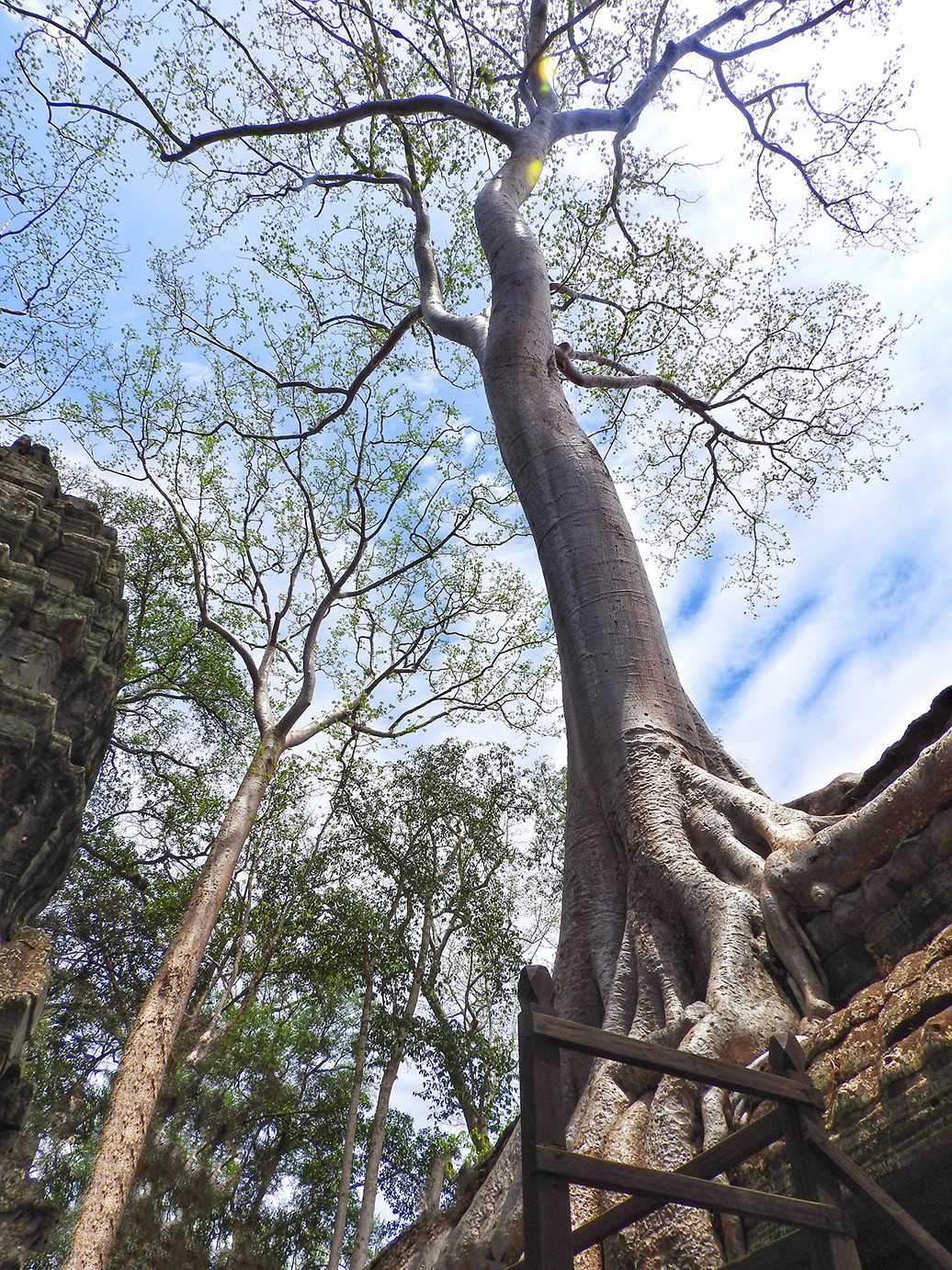
The world famous Tomb Raider Tree in Ta Prohm
The Baphuon Temple is a three-tiered temple built in the 11th century by Khmer King Udayadityavarman II and was dedicated to Hindu God Shiva following Prasat Baphuon. It is a pyramidal representation of mythological sacred five-peak Mount Meru. A large part of the temple complex had collapsed by the 20th century. A large-scale restoration work through the Anastylosis process began with archaeologists marking 300,000 blocks with numbers and labels organized across 10 hectares surrounding the temple. A second restoration project was launched in 1996 known as the largest 3D jigsaw puzzle in the world. The restored temple was finally thrown open to the public in 2011. I have spent hours in this complex during each of my visits and have discovered new things every time. A visit to this temple is at the top of my recommendation list. Climbing stairs is a bit of a workout and a bit scary, but the view of the temple from the upper levels is worth all the effort.
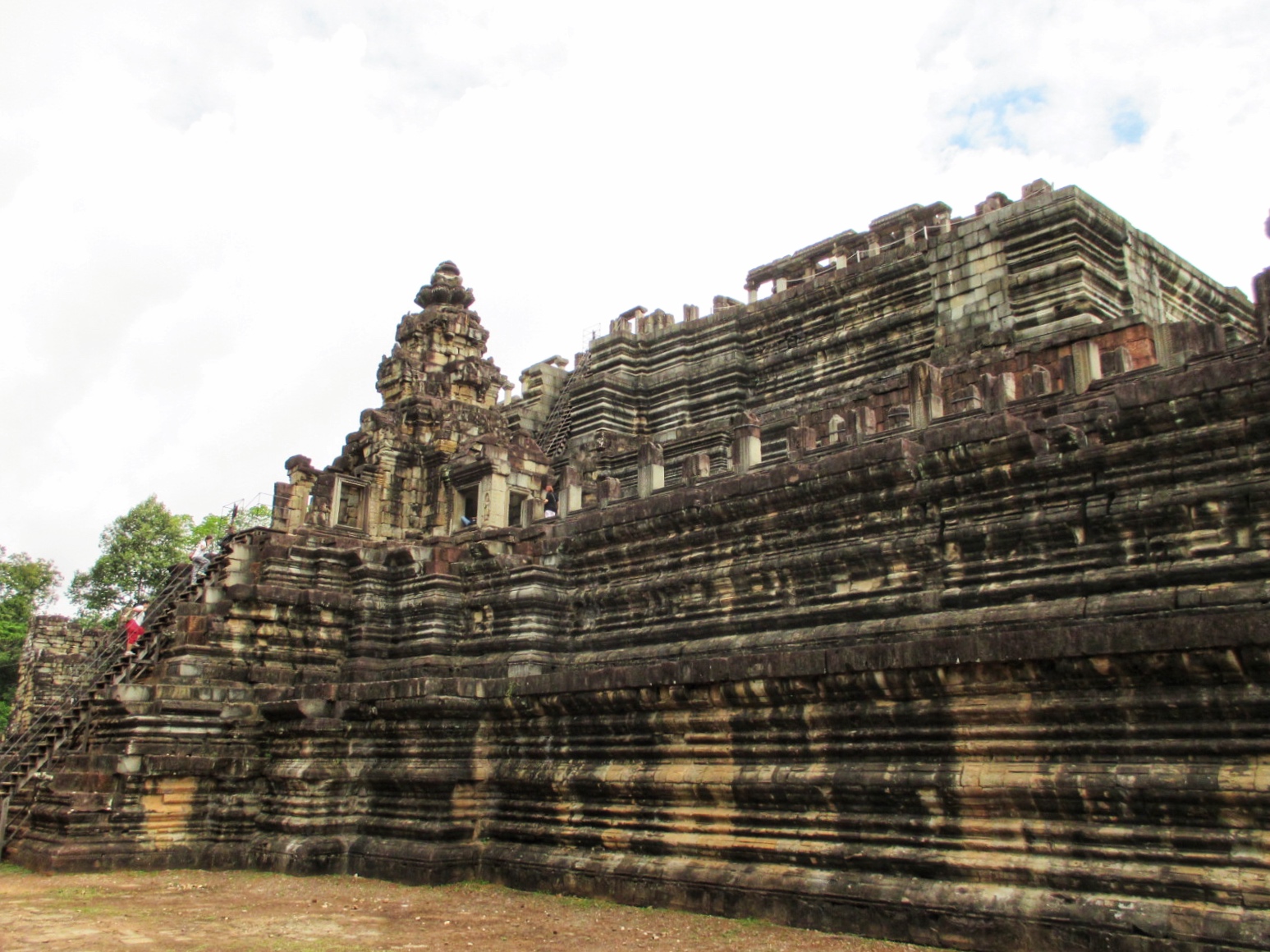
The symmetric structure seen along the climb to the upper tier of the temple
The Baphuon Temple, a UNESCO World Heritage site was built before the city of Angkor Thom was established. In the late 15th century, it was converted into a Buddhist temple from a Hindu temple. This period saw the addition of an enormous reclining Buddha (9 meters tall by 70 meters long) on the temple's west side. The temple is an important example of the transition from Hinduism to Buddhism in Cambodia. Baphuon got its present name after the 16th century. This temple was known as Pisnulok until the 16th century.
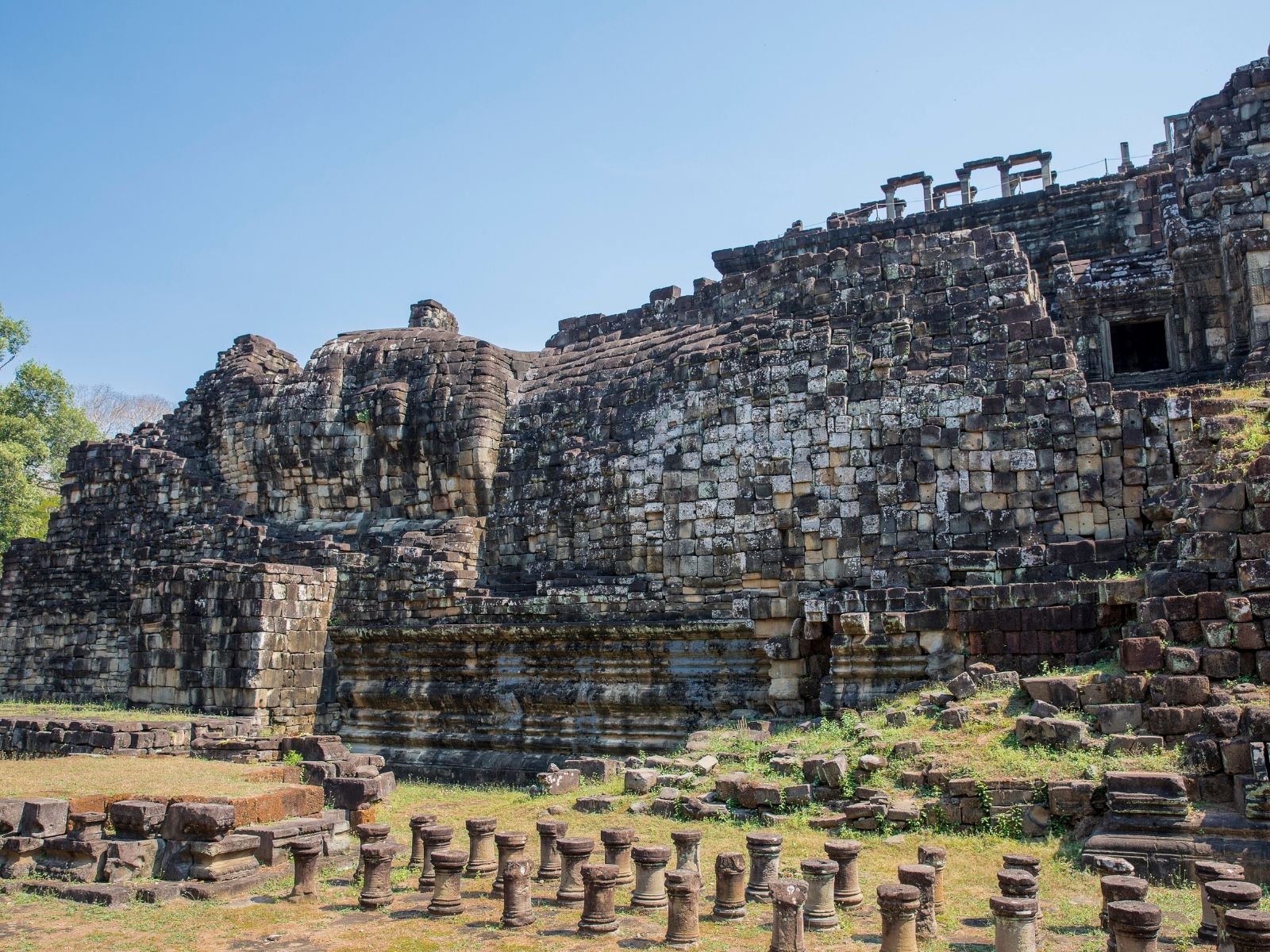
Back side of Baphuon Temple is surrounded by ruins of reclining buddha statue
The Baphuon Temple is a striking example of Khmer architecture, but it has been plagued by instability throughout its history. The temple was built on a foundation of sandy soil, which was inadequate to support such an immense structure. As a result, the temple has been plagued by cracks and other damage caused by the shifting sands. In recent years, extensive restoration work has been carried out to stabilize the temple, but it remains at risk of further damage due to its fragile foundation.
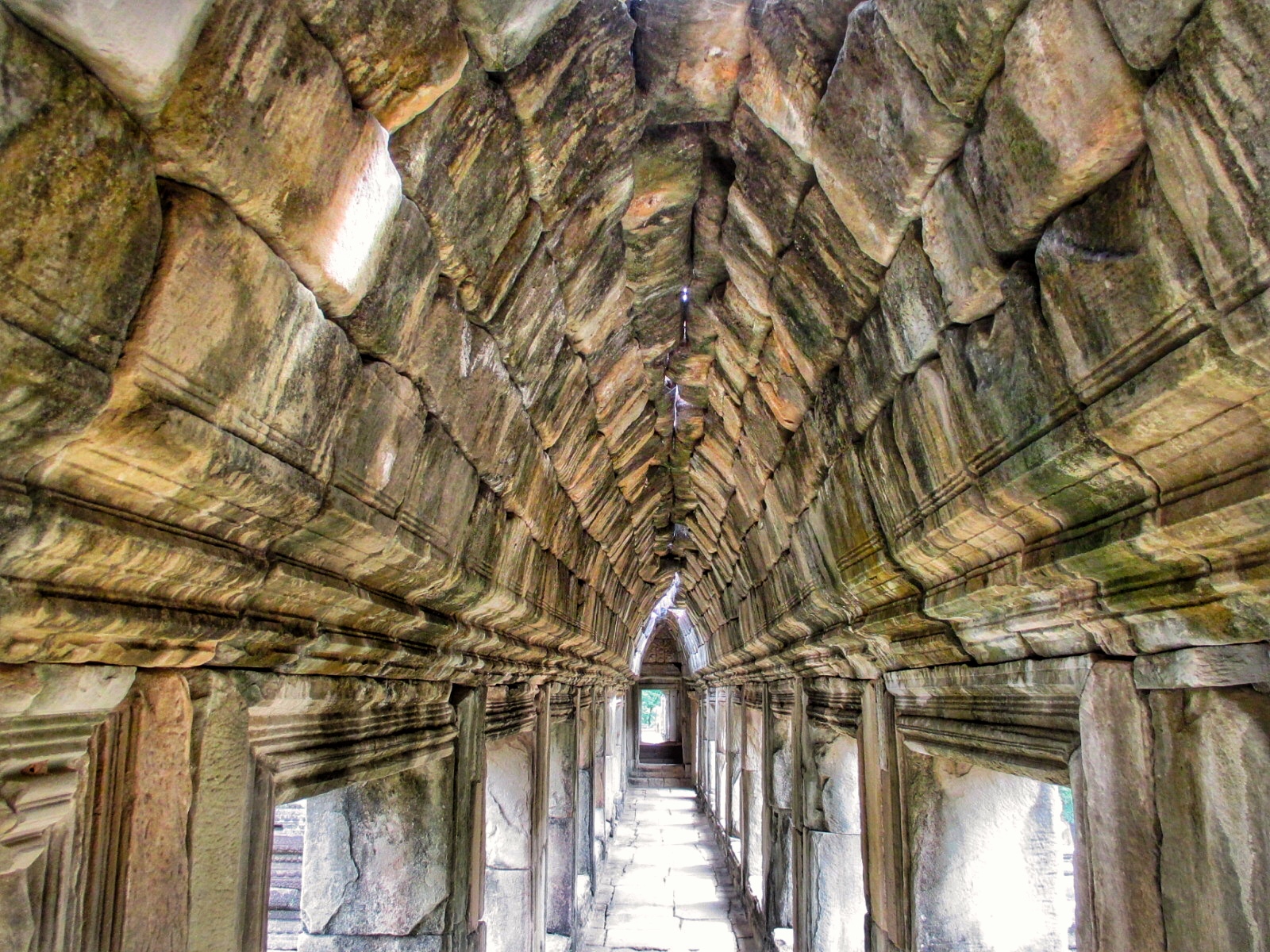
This gallery on the upper tier of the temple creates a tunnel effect
The Baphuon Temple is an incredible sight. It is palatial, with open and large grounds, and it is a prototype for the Baphoun style of design. The main temple is 120 meters long, 100 meters wide, and 34 meters tall. There is a 225-meter long walkway over the moat to reach the main temple. The temple-mountain architecture represents the sacred five-peak mount Meru. The surface of the temple is covered with intricate carvings, and it is an amazing sight to behold.
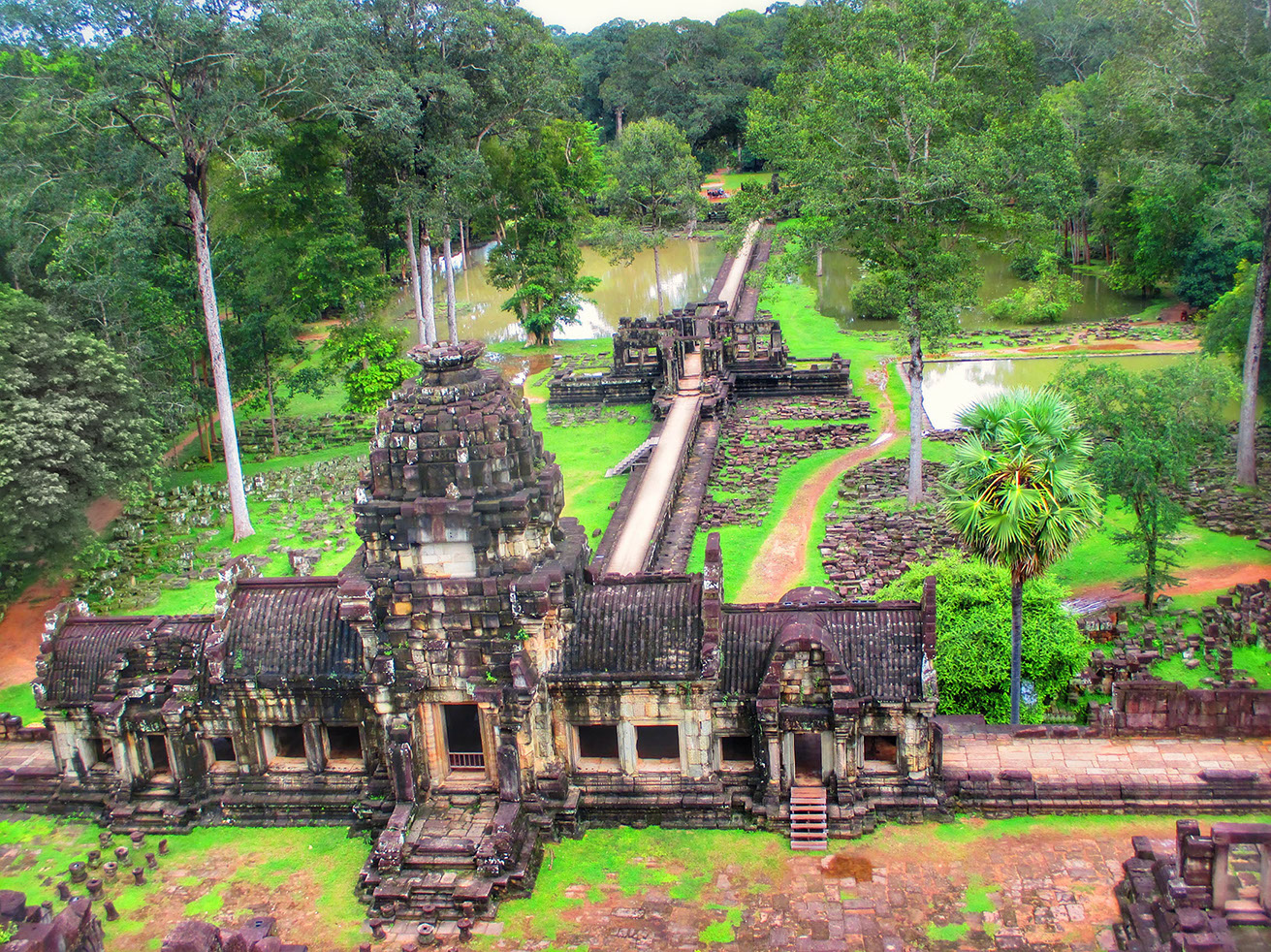
Panoramic view of the long pathway to the temple surrounded by a moat
The main entrance to the temple, known as the gopura, is connected by galleries. Many statues of Hindu deities decorate the gate above the ground level. There are two gates, one on the eastern side and one on the western side. The temple has three enclosures. The concentric gallery lacks the baluster windows of later temples, and is a design unique to the Baphuon.
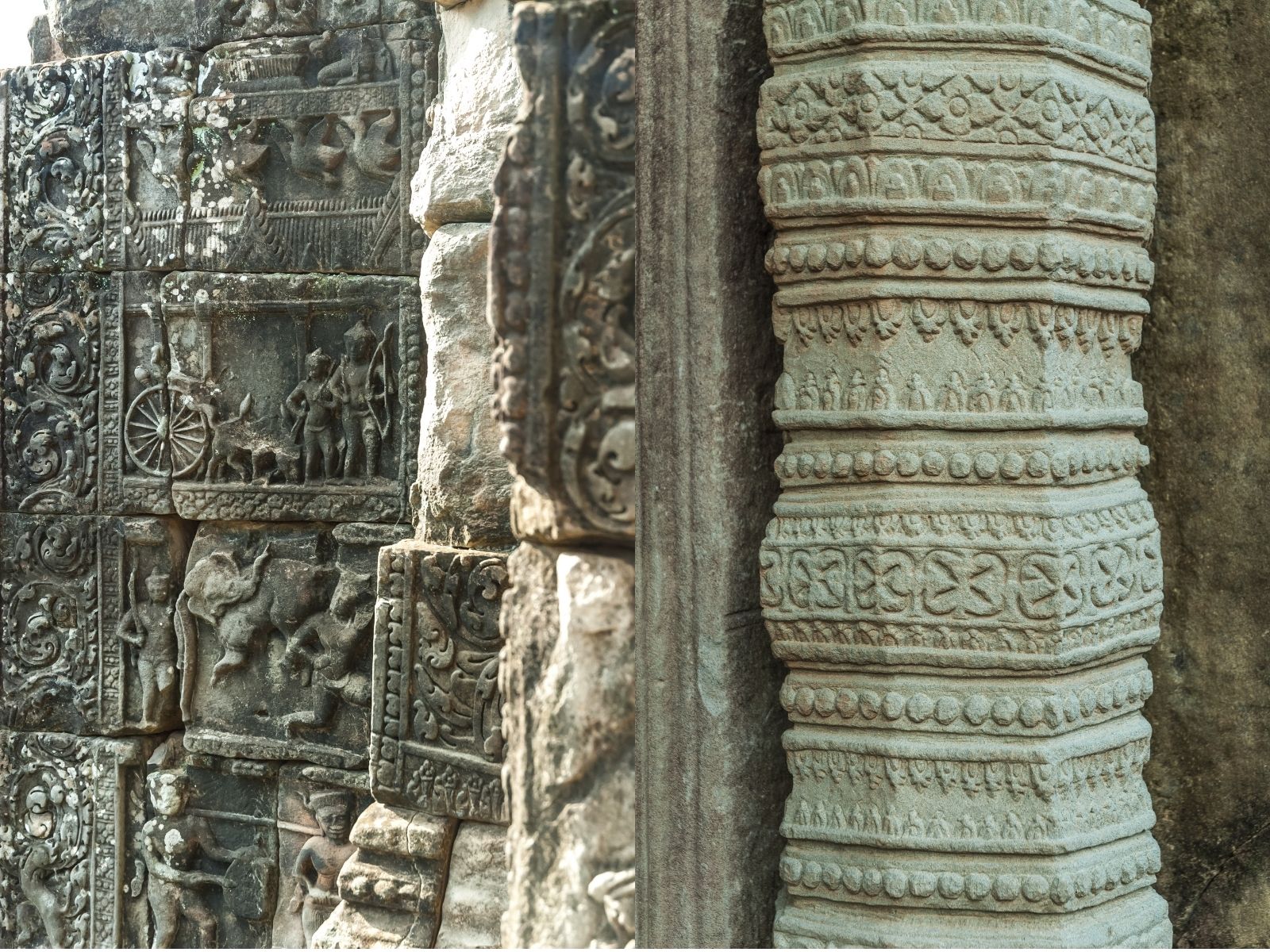
Some of the numerous pillars in the temple decorated with scenes from hindu mythology
There are many more incredible temples in Angkor Wat Complex and the surroundings, some passing the test of time and some in ruins. While a staunch historian would want to explore this extensive treasure trove, one should definitely explore the ones I have spoken about. The magnanimity of the structures, the intricate bas-reliefs, and precision designing will blow you away and leave you mesmerized and in awe of the kings of Khmer Era. It feels like I was on a time machine going back to a different era after each visit and am sure you will feel the same.
Angkor Wat was built for Lord Vishnu, the Hindu god of preservation. Bayon temple was built for Buddha, the founder of Buddhism. Baphoun temple was built for Lord Shiva, the Hindu god of destruction and creation. Each of these temples is a unique and astounding work of architectural engineering.
The temples in Cambodia are called Wat and hence, Angkor Wat. Various temples were built between the 11th and 15th centuries by Khmer kings. The temples are located in the city of Siem Reap, which is about 4 hours north of the capital, Phnom Penh. There are over 100 temples in the area, and they are a popular tourist destination. The most famous temple is Angkor Wat and other notable temples include Bayon, Ta Prohm, and Baphoun.
Under a banyan tree, the Buddha is said to have attained enlightenment. The banyan tree is of religious significance, as are the many banyan trees that grow around the site, it was named "Banyan Temple". As a result of the workers mispronouncing the name, the name became known as Bayon instead of Banyan.
The trees of Ta Prohm are believed to be 100-150 years old. Ta Prohm is one of the most visited temples in Angkor because it is mostly in the same state as when it was discovered, unlike most Angkorian structures. This is due to the photogenic and atmospheric combination of trees sprouting from the ruins and the surrounding forest.
King Udayadityavarman II constructed the Baphuon Temple, which was constructed in the middle of the eleventh century, as his state temple. Baphuon was formerly a Hindu shrine to Shiva. The Mongolian Chou Ta-Kuan visited the temple in the 13th century and called it a "Tower of Bronze."
Disclaimer: This blog may contain affiliate links. At no extra cost to you, we may get a small commission if you buy anything. All products and services we endorse have been personally used or come highly recommended to us. These incomes allow us to keep the community supported and ad-free.
Definitely a once-in-a-lifetime experience! It's a big place and there are other wonderful temples nearby you can visit as well. Even you mentioned that one or half a day is not enough to explore the entire area. Please advise me how long to spend at Angkor during my visit?

Thank you for reading this story. I would suggest to keep at least 2 days for Angkor Wat complex to explore it thoroughly. You can buy a 3-day pass instead of buying two 1-day passes as that will be cheaper. Hope this helps.
This is really interesting read. Temple of angkor is one of my favorite place in south east Asia, i hope i can visit in future till that time i have visited through your story.
Name
Email
Comment